Mughal Architecture in India
Dive deep into Indian architectural heritage with 51 comprehensively documented sites representing mughal architecture. These heritage sites showcase remarkable craftsmanship, innovative construction techniques, and profound historical significance. Our digital archive provides researchers, students, and enthusiasts with detailed architectural documentation, historical research, and preservation insights.
51 sites with scholarly documentation
1 sites with 3D scans for architectural study
Comprehensive measurements
80% average documentation completeness
Total Sites:51
UNESCO Sites:3
ASI Protected:13
3D Scanned:1
Virtual Tours:1
Top Category:Palace (15)
51
Total Sites
3
UNESCO Sites
13
ASI Protected
1
3D Scanned
1
Virtual Tours
51
Featured
51 Sites Found
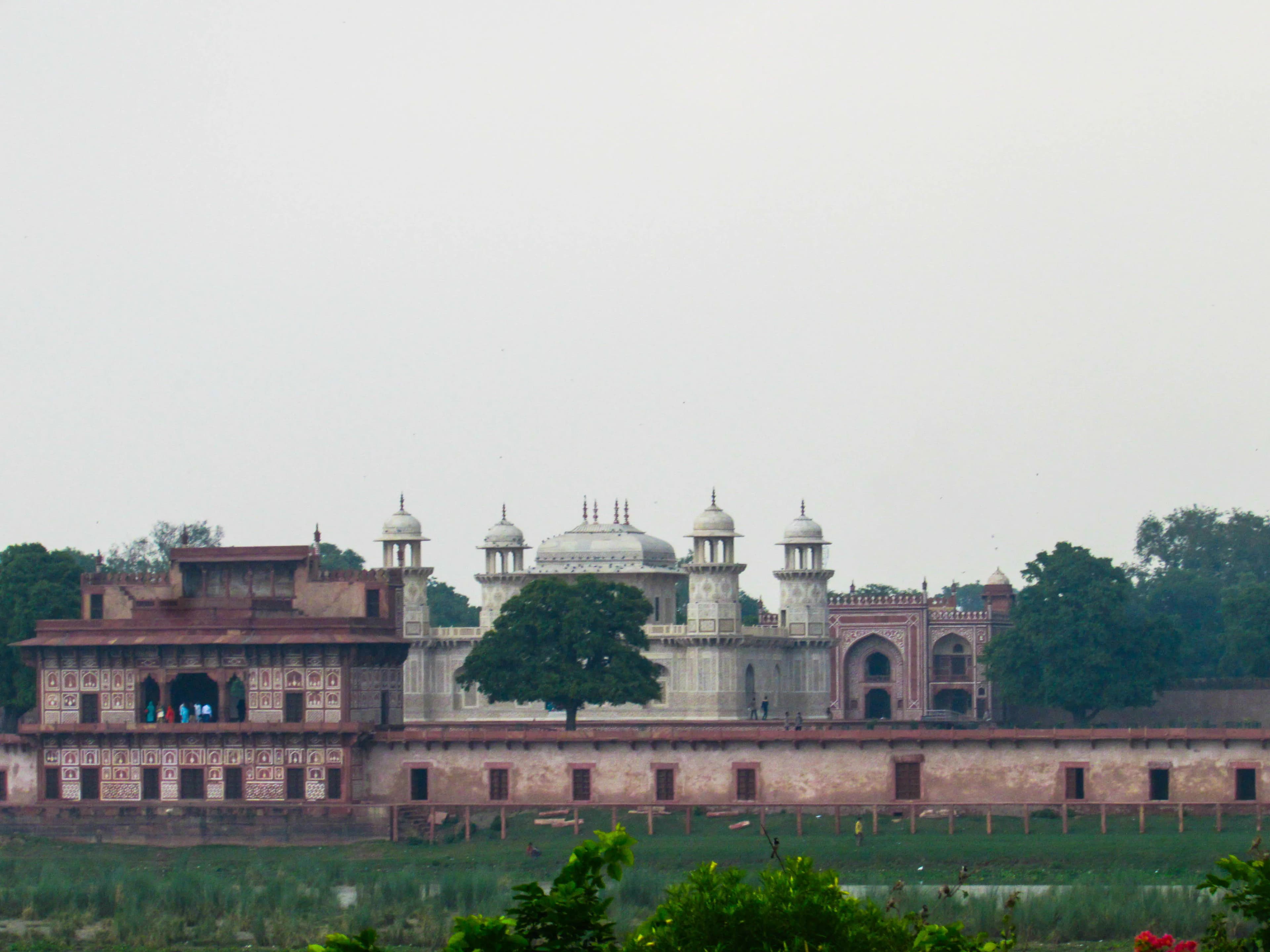
UNESCO
Featured
80% Documented
Rakabganj, Agra, Agra (282003), Uttar Pradesh, India, Uttar Pradesh
The imposing sandstone ramparts of Agra Fort rose before me, shimmering under the Uttar Pradesh sun, a testament to Mughal grandeur and a stark contrast to the bustling chaos just beyond its walls. Having documented countless architectural wonders across Gujarat, I was eager to experience this UNESCO World Heritage Site, a jewel in India’s historical crown. Stepping through the Amar Singh Gate, the primary entrance, I was immediately struck by the sheer scale of the fort. It wasn't just a fortress; it was a city within a city, a microcosm of the Mughal empire at its zenith. The architecture within the fort is a fascinating blend of Hindu and Islamic styles, a reflection of the Mughal emperors' evolving aesthetic sensibilities. The use of red sandstone, so characteristic of Mughal architecture, lends the fort a warm, earthy hue, while intricate marble inlay work adds a touch of delicate elegance. I was particularly captivated by the Diwan-i-Am, the Hall of Public Audience. The vast courtyard, once filled with courtiers and petitioners, now echoed with the whispers of history. The emperor's elevated throne platform, backed by intricately carved pillars and arches, spoke volumes of the power and authority wielded within these walls. Moving deeper into the fort, I entered the Diwan-i-Khas, the Hall of Private Audience. Here, the opulence reached its peak. The exquisite inlay work, featuring precious stones and intricate floral patterns, was breathtaking. I ran my hand lightly over the cool, smooth marble, imagining the Mughal emperors holding court amidst such splendor. The pillars, once adorned with silver and gold, now stand bare, yet their inherent beauty remains undiminished. From the Jahangiri Mahal, the palace of Emperor Akbar’s wife, I could see the glimmering white marble of the Taj Mahal in the distance, a poignant reminder of Shah Jahan's love for Mumtaz Mahal. The architecture of the Jahangiri Mahal, with its broad courtyards and intricately carved jharokhas (overhanging enclosed balconies), showcased a more traditional Hindu influence compared to the later structures within the fort. This subtle shift in architectural style offered a glimpse into the evolving cultural landscape of the Mughal empire. The Khas Mahal, Shah Jahan's private palace, was another highlight. The delicate marble screens, known as jalis, allowed for filtered light and ventilation while maintaining privacy. Standing within these chambers, I could almost feel the presence of the emperor, gazing out at the Yamuna River flowing below. The Musamman Burj, an octagonal tower where Shah Jahan spent his final years imprisoned by his son Aurangzeb, offered a somber contrast to the surrounding opulence. The view of the Taj Mahal from this tower, though breathtaking, was tinged with a sense of melancholy, a reminder of the emperor's tragic fate. The Anguri Bagh, a charbagh-style garden, provided a welcome respite from the grandeur of the palaces. The symmetrical layout, with its intersecting water channels and lush greenery, offered a tranquil oasis within the fort's walls. I sat by the fountain, listening to the gentle murmur of the water, and reflected on the centuries of history that had unfolded within this magnificent complex. As I exited the Agra Fort, the late afternoon sun casting long shadows across the ramparts, I felt a profound sense of awe. The fort wasn't just a collection of buildings; it was a living testament to the Mughal dynasty's artistic and architectural prowess. It was a place where history whispered from every corner, a place where the grandeur of the past met the vibrancy of the present. From the intricate inlay work to the imposing sandstone walls, every detail spoke of a bygone era, leaving an indelible impression on this traveler from Gujarat.
Fort
Rajput Period

Featured
80% Documented
Fort Road, Prayagraj, Prayagraj (211001), Uttar Pradesh, India, Uttar Pradesh
The imposing sandstone ramparts of Allahabad Fort, rising from the confluence of the Ganga and Yamuna, exude an aura of timeless power. Standing at the cusp of this historic site, I felt the weight of centuries pressing down, a palpable sense of the empires that have risen and fallen within these walls. My lens, accustomed to the intricate carvings of Khajuraho and the majestic stupas of Sanchi, found a new, stark beauty in the fort's robust, almost brutal architecture. Built by the Mughal emperor Akbar in 1583, the fort displays a fascinating blend of military pragmatism and artistic flair. The sheer scale of the structure is breathtaking. Walking along the ramparts, I could trace the strategic brilliance of its design, the placement of bastions and watchtowers offering a commanding view of the surrounding plains and the sacred confluence. The walls, though weathered by time and the elements, retain a sense of impregnability, a testament to the engineering prowess of the Mughal era. Within the fort’s confines, a different world unfolds. The Akshayavat, an ancient fig tree revered as immortal, stands as a silent witness to the fort's history. While photography isn't permitted within the tree's enclosure, the palpable sense of reverence surrounding it was a powerful experience in itself. Local legends whisper of its significance in Hindu mythology, adding another layer to the fort's rich tapestry of stories. The architecture within the fort displays a distinct shift in style compared to the outer fortifications. The delicate carvings on the Zenana, the women's quarters, offer a glimpse into the more refined aspects of Mughal life. Intricate jaali work, allowing for ventilation while maintaining privacy, showcases the artisans' skill. The contrast between the rough-hewn exterior and the ornate interiors is striking, reflecting the dual nature of the fort – a military stronghold and a royal residence. One of the most captivating structures within the fort is the Ashoka Pillar. Its smooth, polished surface, inscribed with edicts of Emperor Ashoka, stands in stark contrast to the rough texture of the surrounding sandstone. Running my hand over the cool, ancient script, I felt a direct connection to a period centuries before the Mughals, a reminder of the layers of history embedded within this site. The pillar, predating the fort itself, serves as a powerful symbol of the continuity of Indian civilization. My photographic journey through the fort led me to the Patalpuri Temple, an underground shrine believed to be one of the oldest in Prayagraj. Descending into the dimly lit sanctum, I felt a sense of awe and mystery. The architecture here is simpler, more ancient, a stark departure from the Mughal grandeur above. The play of light and shadow added to the temple's mystique, creating an atmosphere conducive to contemplation and reflection. Documenting Allahabad Fort was more than just capturing its physical form; it was about capturing the spirit of the place. It was about understanding the confluence of cultures, religions, and empires that have shaped its identity. From the imposing ramparts to the intricate carvings, from the ancient Ashoka Pillar to the subterranean Patalpuri Temple, every corner of the fort whispered stories of the past. As I packed my equipment, I knew I was carrying more than just photographs; I was carrying the echoes of history, etched in stone and light.
Fort
Mughal Rajput Period
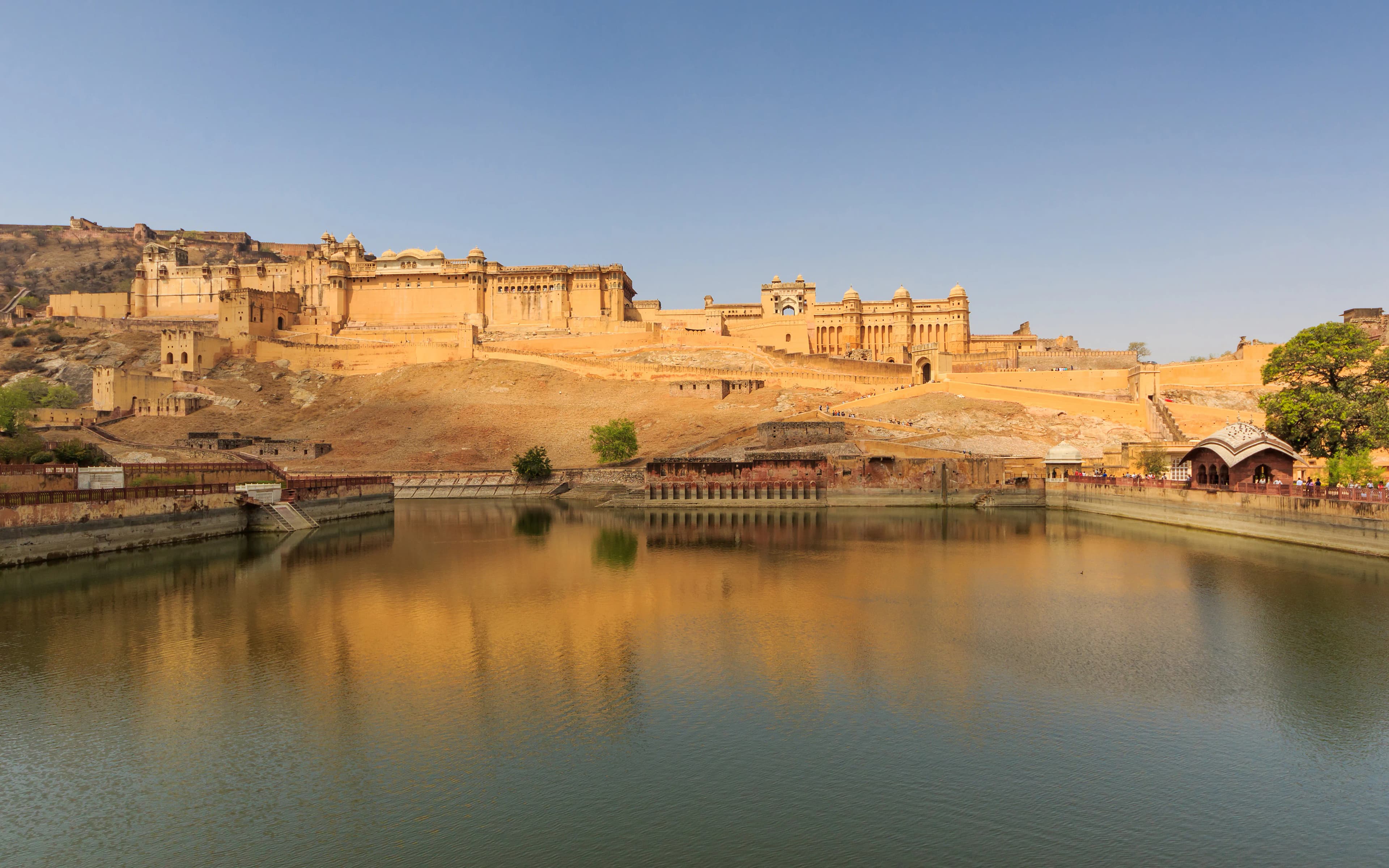
UNESCO
Featured
80% Documented
Devisinghpura, Jaipur, Amer (302001), Rajasthan, India, Rajasthan
The ochre walls of Amber Fort shimmered under the Rajasthani sun, a mirage-like vision rising from the dusty Aravalli hills. Having explored countless forts across North India, I thought I was prepared for Amber, but its sheer grandeur and intricate beauty silenced even my seasoned traveler’s heart. My ascent wasn't on elephant-back, the traditional tourist route, but rather by jeep, a bumpy ride that offered panoramic views of the sprawling complex below. This perspective allowed me to appreciate the fort’s strategic location, guarding the old Jaipur city with its formidable ramparts. Entering through the Suraj Pol (Sun Gate), I was immediately struck by the fort's layered architecture, a testament to the Rajput rulers who expanded and embellished it over centuries. The courtyard, a vast expanse of sandstone, buzzed with activity even in the midday heat. Guides recounted tales of Rajput valor, tourists snapped selfies against the backdrop of ornate arches, and the echoes of centuries past seemed to whisper through the breeze. My exploration began with the Diwan-i-Am, the Hall of Public Audience. The intricate carvings on the pillars, depicting elephants and floral motifs, were a feast for the eyes. I could almost imagine the Maharaja holding court here, addressing his subjects from the raised platform. The sheer scale of the courtyard, coupled with the delicate artistry of the carvings, created a powerful juxtaposition of strength and refinement. From there, I moved to the Diwan-i-Khas, the Hall of Private Audience. Here, the opulence was even more pronounced. The walls were inlaid with intricate mosaics of glass and precious stones, reflecting the sunlight in a dazzling display. The famed Sheesh Mahal, or Mirror Palace, was a breathtaking spectacle. Even the faintest flicker of a candle is said to illuminate the entire hall, a testament to the ingenious design and craftsmanship. I spent a considerable amount of time here, captivated by the shimmering surfaces and the stories they held. The Sukh Niwas, or Hall of Pleasure, offered a welcome respite from the midday sun. An ingenious system of channels once carried cool water through the hall, creating a natural air conditioning system. The intricate latticework screens allowed for privacy while permitting the passage of the cooling breeze. It was easy to imagine the royal family seeking refuge here during the scorching summer months. Ascending further, I reached the zenana, the women's quarters. Here, the architecture shifted subtly. While still ornate, there was a greater emphasis on privacy and seclusion. Interconnected courtyards, screened balconies, and hidden passages offered glimpses into the lives of the royal women, their world both luxurious and confined. Looking out from the highest point of the fort, the panoramic view of Maota Lake and the surrounding hills was simply stunning. The city of Jaipur sprawled in the distance, a vibrant tapestry of colors and sounds. From this vantage point, I could truly appreciate the strategic brilliance of Amber’s location. My visit to Amber Fort was more than just a sightseeing trip; it was a journey through time. The fort’s architecture, its intricate details, and its commanding presence spoke volumes about the power and artistry of the Rajput rulers. As I descended, leaving the ochre walls behind, I carried with me not just photographs and memories, but a deeper understanding of Rajasthan's rich history and cultural heritage. Amber Fort is not just a fort; it's a living testament to a bygone era, a place where history whispers from every stone.
Fort
Rajput Period

Featured
80% Documented
Asirgarh Fort, Burhanpur (450331), Madhya Pradesh, India, Madhya Pradesh
The wind whipped around me, carrying whispers of history as I stood atop Asirgarh Fort, gazing out at the tapestry of the Satpura Range. This isn't Rajasthan, my usual stomping ground, but the whispers here in Burhanpur, Madhya Pradesh, are just as compelling. This isn't the delicate filigree work of Rajput architecture I'm accustomed to; Asirgarh is a different beast altogether, a formidable fortress carved into the very rock of a triangular hill, rising nearly 800 feet from the plains below. The climb itself was an experience. The winding path, originally carved by nature and later fortified by human hands, felt like stepping back in time. Each turn revealed another layer of history, from the ancient rock-cut steps to the later additions of ramparts and gateways. The sheer scale of the fortification is breathtaking. Unlike the sandstone forts of Rajasthan, Asirgarh’s basalt foundations lend it a dark, imposing presence. It's a fortress built to withstand sieges, a fact reinforced by the numerous water tanks, granaries, and underground chambers I explored within its walls. Passing through the multiple gateways, each a formidable defense in its own right, I felt a palpable shift in atmosphere. The air within the fort walls was cooler, quieter, a stark contrast to the bustling plains below. The architecture here is a blend of styles, reflecting the fort’s diverse history under the Faruqi dynasty, the Mughals, and the Marathas. While the core structure speaks of robust military engineering, later additions, like the Jami Masjid, showcase intricate carvings and a touch of elegance amidst the martial austerity. The Jami Masjid, with its towering minarets and serene courtyard, offered a moment of tranquility. The play of light and shadow on the basalt columns created an almost ethereal atmosphere. The mosque's architecture, while bearing some resemblance to Mughal styles, possesses a unique character, a testament to the local craftsmanship and the fusion of influences that shaped this region. Exploring the upper reaches of the fort, I came across the Asir or Ashirgad, the highest point and the source of the fort's name. The panoramic view from here was simply stunning. The Tapti River snaked through the plains below, a silver ribbon against the green expanse. I could see for miles, imagining the strategic advantage this vantage point offered to the fort's defenders. It's no wonder Asirgarh earned the moniker "Dakshin ka Dwar" or "Gateway to the South." The water management system within the fort is particularly impressive. Numerous tanks and reservoirs, some carved directly into the rock, ensured a continuous supply of water even during prolonged sieges. The ingenuity of the builders is evident in the intricate network of channels and cisterns that collected and distributed rainwater throughout the fort. This foresight, so crucial in this arid region, speaks volumes about the strategic planning that went into Asirgarh’s construction. Beyond the strategic and architectural marvels, Asirgarh holds a certain mystique. Walking through its deserted chambers and along its crumbling ramparts, I felt a connection to the past, to the countless lives that had unfolded within these walls. The silence here is not empty; it’s filled with the echoes of history, the whispers of battles fought and empires won and lost. It's a different kind of beauty than the ornate palaces of Rajasthan, a raw, powerful beauty that speaks of resilience and the enduring legacy of human endeavor. Asirgarh is more than just a fort; it’s a testament to human ingenuity and a poignant reminder of the ebb and flow of power across the centuries.
Fort
Maratha Period
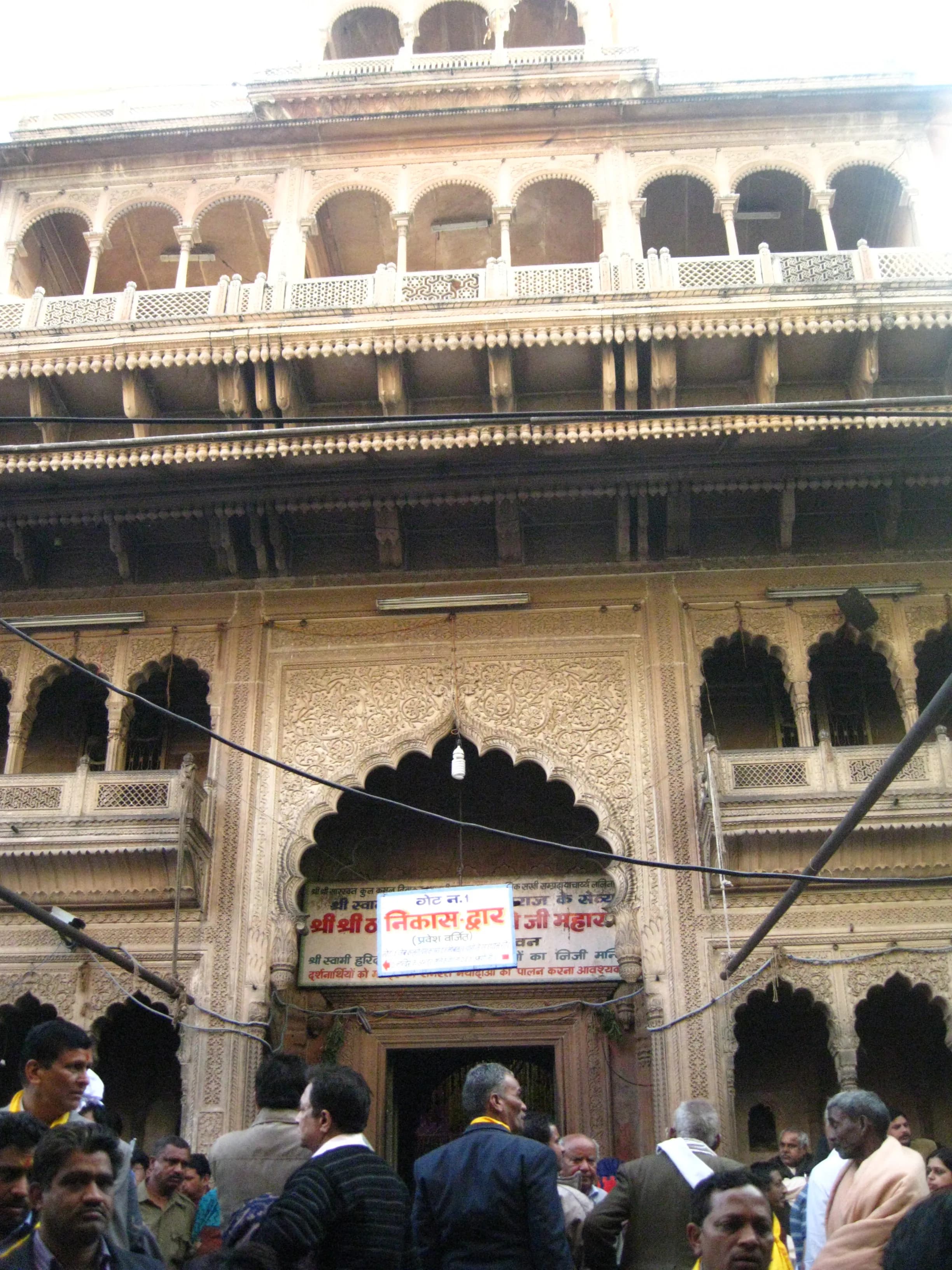
Featured
80% Documented
Banke Bihari Gali, Mathura, Vrindavan (281121), Uttar Pradesh, India, Uttar Pradesh
The air in Vrindavan hummed with a palpable devotion, a tangible energy that seemed to emanate from the very stones of the Banke Bihari Temple. Having explored the basalt-carved caves and intricately sculpted temples of Maharashtra, I arrived at this North Indian shrine with a keen eye for architectural nuances and a heart open to a different flavour of spirituality. The jostling crowds, the insistent chants, and the overwhelming fragrance of incense were a stark contrast to the quiet serenity I was accustomed to. The temple, nestled in the heart of Vrindavan, stands as a testament to the fervent devotion to Krishna, specifically his "Banke Bihari" form – the playfully mischievous deity who steals butter and hearts with equal ease. Unlike the grand, sprawling temple complexes I’ve seen in the South, Banke Bihari Temple is relatively compact, almost intimate. Its architecture reflects the Rajasthani style, a departure from the typical North Indian Nagara style I expected. The intricately carved sandstone facade, a warm ochre hue, is adorned with delicate latticework screens known as *jalis*. These screens not only serve as decorative elements but also allow glimpses of the deity within, creating an air of mystery and anticipation. Entering the temple felt like stepping into another world. The narrow passage leading to the inner sanctum was packed with devotees, their faces alight with devotion. The rhythmic clang of cymbals, the fervent chanting of "Radhe Radhe," and the occasional outburst of ecstatic singing created an atmosphere both chaotic and captivating. The jostling wasn't aggressive; it felt more like a collective surge of spiritual energy, everyone pushing forward towards the same divine source. Finally, I caught a glimpse of Banke Bihari. The deity, adorned in opulent silks and jewels, stood under a canopy of flowers, his flute held delicately in his hand. The image, though fleeting, was mesmerizing. The curtains that veil the deity are drawn frequently, a unique practice in this temple. Locals believe that gazing at Banke Bihari for too long can induce a trance-like state, and the curtains are drawn to break the spell. This practice, though unusual, added to the mystique and heightened the sense of anticipation. The temple's inner courtyard, though crowded, offered a brief respite from the intensity of the sanctum. Here, I observed the architectural details more closely. The pillars supporting the roof were intricately carved with floral motifs and scenes from Krishna's life, a testament to the skill of the artisans. The floor, worn smooth by centuries of footsteps, felt imbued with a sense of history and devotion. One striking difference I noted compared to Maharashtrian temples was the absence of elaborate *gopurams* or towering gateways. The focus here seemed to be entirely on the inner sanctum and the deity within. The architecture, while beautiful, served as a backdrop to the intense spiritual experience, rather than being the primary focus. Leaving the temple, I felt a sense of both exhilaration and exhaustion. The experience was overwhelming, a sensory overload of sights, sounds, and emotions. While the architectural style differed vastly from the caves and temples of my home state, the underlying current of devotion felt familiar. The Banke Bihari Temple, with its unique rituals and palpable energy, offered a glimpse into a different facet of Indian spirituality, a testament to the diverse and vibrant tapestry of faith that weaves through this land. It was a journey not just to a different state, but to a different dimension of devotion.
Temple
Rajput Period

Featured
80% Documented
Barrackpore Trunk Road, North 24 Parganas, Barrackpore (700120), West Bengal, India, West Bengal
The Hooghly River flowed serenely beside me, a silent witness to the centuries of history etched into the walls of Barrackpore Fort. Coming from Rajasthan, a land of sandstone giants and intricate palaces, I was curious to see how this colonial-era fort would compare. The difference was stark, yet the sense of history, of power residing within these walls, was just as palpable. Unlike the imposing, desert-hued fortifications I’m accustomed to, Barrackpore presented a more subdued, almost understated facade. The laterite walls, bleached by the sun and kissed by the humid Bengal air, lacked the grandeur of Mehrangarh or the delicate artistry of Hawa Mahal. Yet, their very simplicity spoke volumes. This wasn’t a fort built to impress with ornamentation; this was a structure designed for functionality, for military control. Entering through the main gate, I was struck by the spaciousness of the grounds. Vast lawns stretched out, punctuated by mature trees offering respite from the midday sun. It felt more like a park than a fortress, a stark contrast to the tightly packed structures within Rajasthan's forts. This open layout, I learned, was a deliberate choice by the British, reflecting a different military strategy and a need to accommodate large numbers of troops. The Semaphore Tower, a prominent landmark within the fort, immediately drew my attention. Its stark white form against the blue sky was a visual reminder of the fort's strategic importance in communication. I climbed the narrow, winding staircase to the top, the humid air clinging to me like a second skin. From this vantage point, I could see the sprawling cantonment area and the meandering Hooghly, understanding how vital this tower was for relaying messages in the pre-telegraph era. The Government House, now a museum, offered a glimpse into the lives of the British officials who once resided here. While smaller than the opulent palaces of Rajasthan's royalty, the house exuded a quiet elegance. The high ceilings, large windows, and airy verandas were designed to combat the Bengal heat, a practical consideration that echoed in the architecture. Inside, the exhibits showcased artifacts from the colonial period, including furniture, weaponry, and documents, offering a tangible connection to the past. Wandering through the grounds, I came across the Lady Canning’s Rose Garden. Named after Charlotte Canning, the wife of the then Governor-General, the garden was a surprising burst of color and fragrance within the otherwise austere setting. It was a reminder that even within the confines of a military fort, there was a desire for beauty and tranquility. Perhaps the most poignant part of my visit was standing at the site of the 1857 mutiny memorial. This unassuming plaque marked the spot where Mangal Pandey, a sepoy in the British East India Company's army, made his stand against the controversial Enfield rifles, sparking the first flames of the Sepoy Mutiny. The weight of history pressed down on me, a stark reminder of the struggles for independence that shaped this nation. Barrackpore Fort isn’t a place of elaborate carvings or breathtaking vistas. It’s a place of quiet power, a place where history whispers from the laterite walls and the rustling leaves of ancient trees. It’s a testament to a different era, a different architectural style, and a different kind of story. As I left the fort, the image of the Hooghly flowing silently by stayed with me, a constant reminder of the ebb and flow of time and the enduring legacy of this historic site.
Fort
British Colonial Period
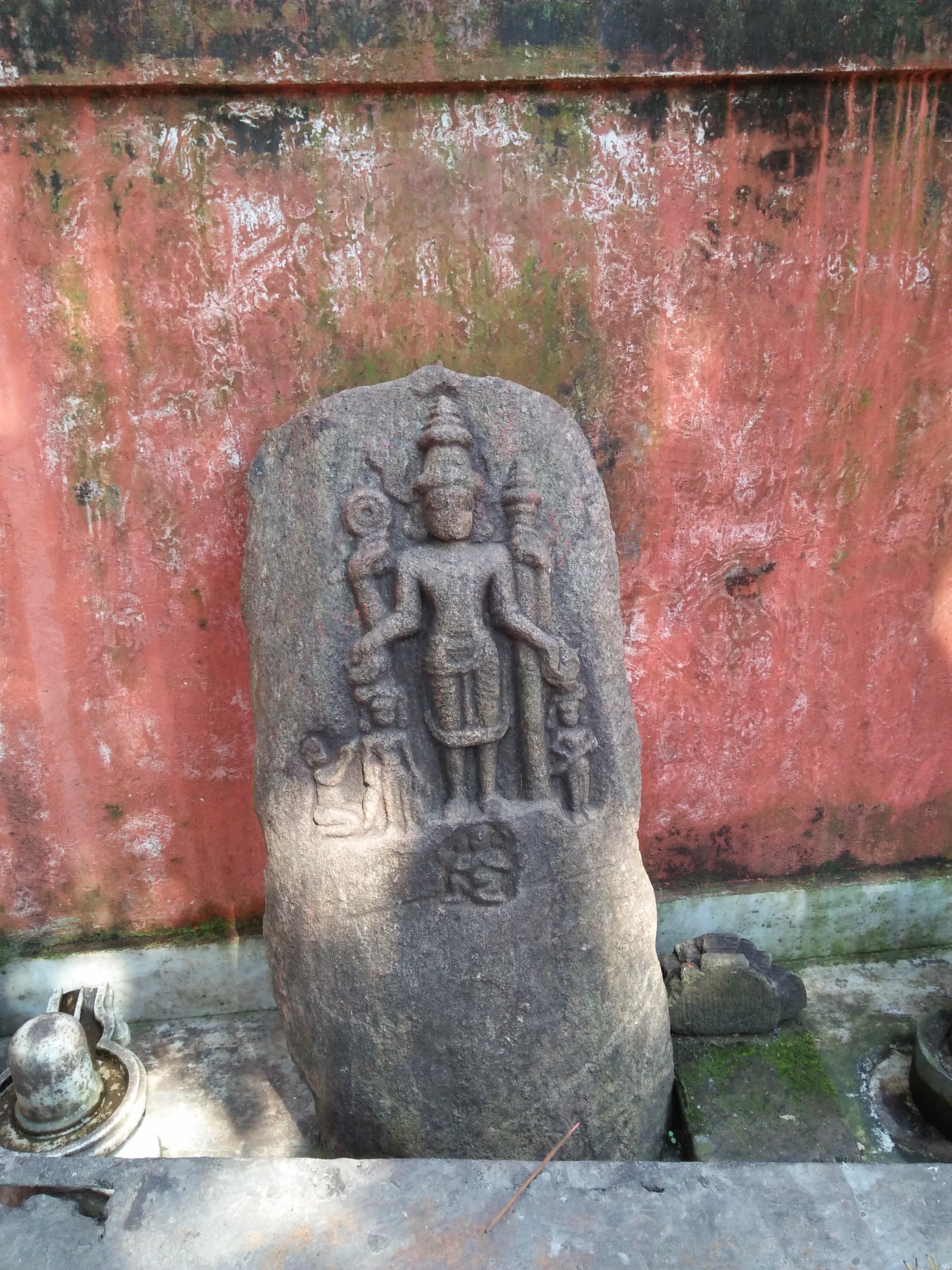
Featured
80% Documented
Basistha Road, Kamrup Metropolitan, Guwahati (781029), Assam, India, Assam
The air hung heavy with the scent of incense and damp earth as I stepped onto the grounds of the Basistha Ashram, home to the ancient Basistha Temple. Nestled at the foothills of the Meghalaya plateau, south of the Brahmaputra River, the temple complex felt worlds away from the bustling city of Guwahati. The roar of traffic faded, replaced by the gentle murmur of the Sandhya River, which flows through the ashram, cascading over moss-covered rocks. This wasn't just a temple; it was a sanctuary woven into the very fabric of the landscape. My lens immediately gravitated towards the main temple, dedicated to the sage Basistha. Constructed primarily of stone, it stood as a testament to time and devotion. Unlike the towering, ornate structures I'm accustomed to in Madhya Pradesh, this temple possessed a more intimate, almost humble grandeur. The shikhara, while present, wasn't the dominant feature. Instead, my eye was drawn to the intricate carvings that adorned the stone surfaces. Depictions of deities, mythical creatures, and floral motifs, though weathered by centuries of monsoon rains, still held a remarkable clarity. The style, distinct from the temple architecture I've documented in central India, hinted at influences from both traditional Assamese and possibly even Ahom architectural traditions. I spent hours exploring the complex, my camera a constant companion. The ashram sprawled across a verdant hillside, dotted with smaller shrines, meditation caves, and ancient trees. Each element seemed to harmonize with the natural surroundings, creating a sense of peaceful coexistence. One particular cave, said to be the original dwelling of Sage Basistha, captivated me. The low, dark entrance opened into a surprisingly spacious chamber, cool and quiet, a stark contrast to the humid air outside. Sunlight filtered through a small opening in the ceiling, illuminating a small lingam at the center. The air within the cave was thick with a palpable sense of history and spirituality. The Sandhya River, considered sacred, played a central role in the life of the ashram. Devotees bathed in its waters, offering prayers and performing rituals. I observed a group of women dressed in vibrant Assamese silks, their laughter echoing through the valley as they gathered water. This everyday act, imbued with religious significance, became a powerful visual narrative, showcasing the living connection between the temple and the community. As the day progressed, the light shifted, casting long shadows across the stone carvings. The late afternoon sun painted the temple in a warm, golden hue, revealing textures and details I hadn’t noticed before. I focused my lens on a particularly intricate carving of Lord Vishnu, noticing the subtle variations in the depth of the carving, the way the light played across the stone, creating an almost three-dimensional effect. It was in these quiet moments of observation that I truly appreciated the artistry and skill of the ancient craftsmen. My time at the Basistha Temple was more than just a photographic expedition; it was an immersive experience. It offered a glimpse into a rich cultural tapestry, woven with threads of mythology, spirituality, and architectural ingenuity. While the temples of Madhya Pradesh hold a special place in my heart, the Basistha Temple, with its unique charm and serene atmosphere, has etched its own indelible mark on my photographic journey. It reminded me that the beauty of heritage lies not just in grand monuments, but also in the quiet whispers of history, the sacredness of nature, and the enduring faith of a community.
Temple
Ahom Period
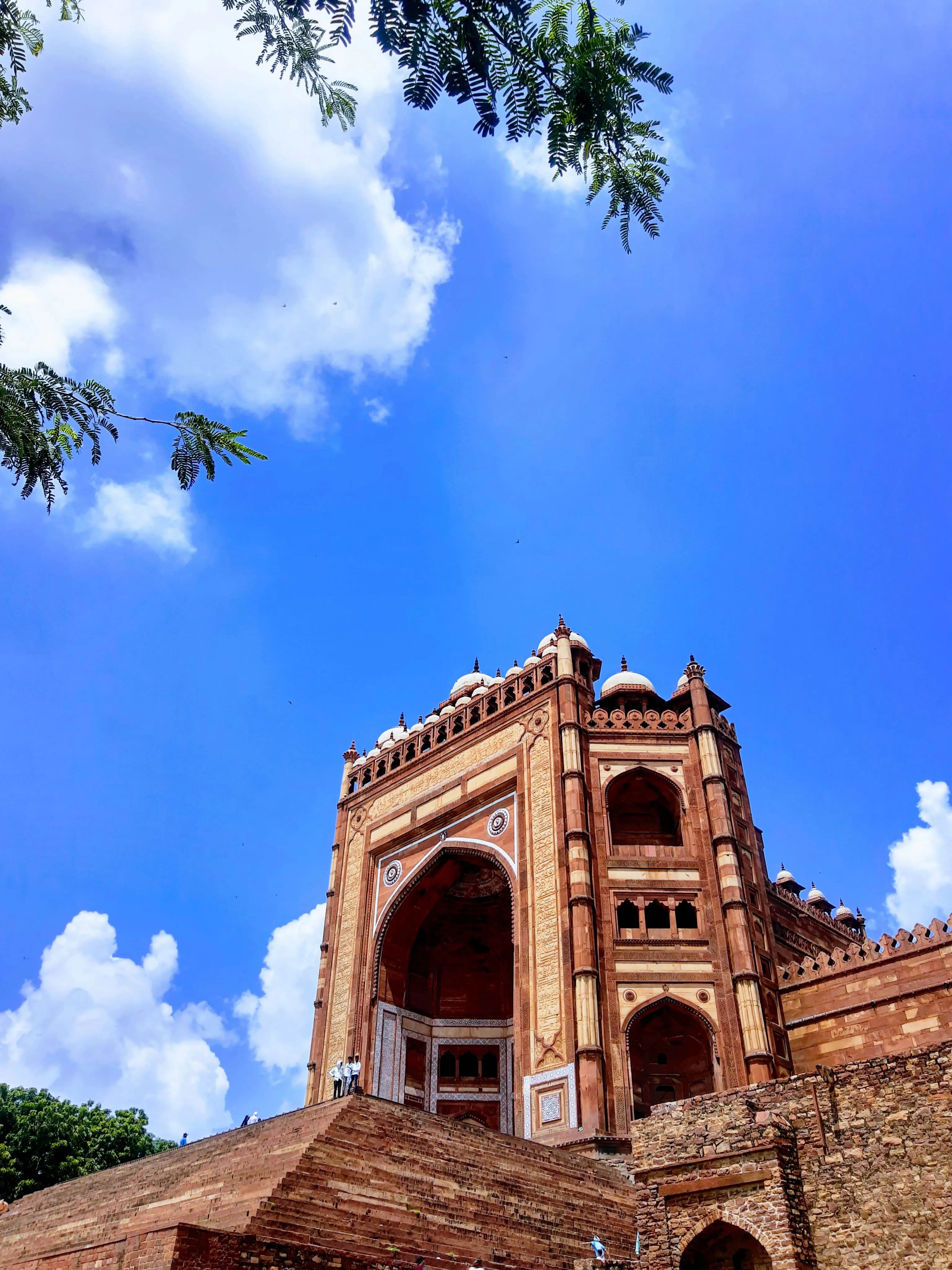
Featured
80% Documented
Buland Darwaza, Agra, Fatehpur Sikri (283110), Uttar Pradesh, India, Uttar Pradesh
The sheer scale of Buland Darwaza hits you long before you reach its imposing shadow. Emerging from the gentle slopes surrounding Fatehpur Sikri, this colossal gateway, a reddish-brown sentinel against the Uttar Pradesh sky, feels less like an entrance and more like a declaration. Having crisscrossed North India for years, documenting its architectural marvels, I can confidently say few structures possess the immediate, breathtaking grandeur of Akbar’s victory arch. My most recent visit to Fatehpur Sikri began, as it always does, with a sense of anticipation. The deserted city, a Mughal ghost town whispering stories of a glorious past, holds a particular fascination for me. But even after numerous visits, the Buland Darwaza still manages to evoke awe. Fifty-two meters high, it dwarfs everything around it, a testament to Mughal ambition and architectural prowess. The semi-circular steps leading up to the gateway already begin to prepare you for the sheer scale of what lies ahead. Passing through the towering archway, I ran my hand over the intricately carved sandstone. The red sandstone, sourced from the nearby quarries, glows with a warmth that belies its age. The intricate calligraphy, primarily verses from the Quran, adds another layer of artistry. These inscriptions, deeply etched into the stone, are not mere decorations; they are proclamations of faith, chronicles of victory, and testaments to the artistic sensibilities of the era. I spent a considerable amount of time deciphering the Persian inscriptions, a tangible link to the Mughal emperors who once walked these very grounds. The architectural style of Buland Darwaza is a fascinating blend of Persian and Indian influences. The towering arch, a characteristically Persian feature, is complemented by the chattris, small domed pavilions, which are distinctly Indian. This fusion of styles, so typical of Mughal architecture, is perhaps most perfectly realized in this magnificent gateway. The interplay of light and shadow on the carved surfaces creates a constantly shifting tapestry of textures, a visual feast for anyone with an appreciation for architectural detail. Looking down from the gateway offers a panoramic view of Fatehpur Sikri, a city frozen in time. The Jama Masjid, the palaces, the courtyards – all spread out below like a meticulously crafted miniature. It's easy to imagine the bustling activity that once filled these spaces, the courtiers, the soldiers, the merchants, all moving within the confines of Akbar’s magnificent capital. Standing there, I felt a palpable connection to history, a sense of being a small part of a larger narrative that stretches back centuries. One of the most striking features of the Buland Darwaza, and something that often goes unnoticed by casual observers, is the subtle shift in scale as you ascend. The lower portions of the gateway are proportionally larger, creating a sense of perspective and emphasizing the height. This clever architectural trick enhances the sense of grandeur and makes the gateway appear even taller than it actually is. It’s a testament to the ingenuity of the Mughal architects and their mastery of proportion and scale. As the sun began to set, casting long shadows across the deserted city, I took one last look at the Buland Darwaza. The setting sun bathed the sandstone in a warm, golden light, accentuating the intricate carvings and giving the gateway an almost ethereal glow. It was a fitting end to my visit, a moment of quiet contemplation in the presence of a truly magnificent structure. The Buland Darwaza is more than just a gateway; it's a symbol of Mughal power, a testament to architectural brilliance, and a timeless reminder of India’s rich and layered history. For anyone traveling through North India, it is an absolute must-see.
Gateway
Mughal Rajput Period
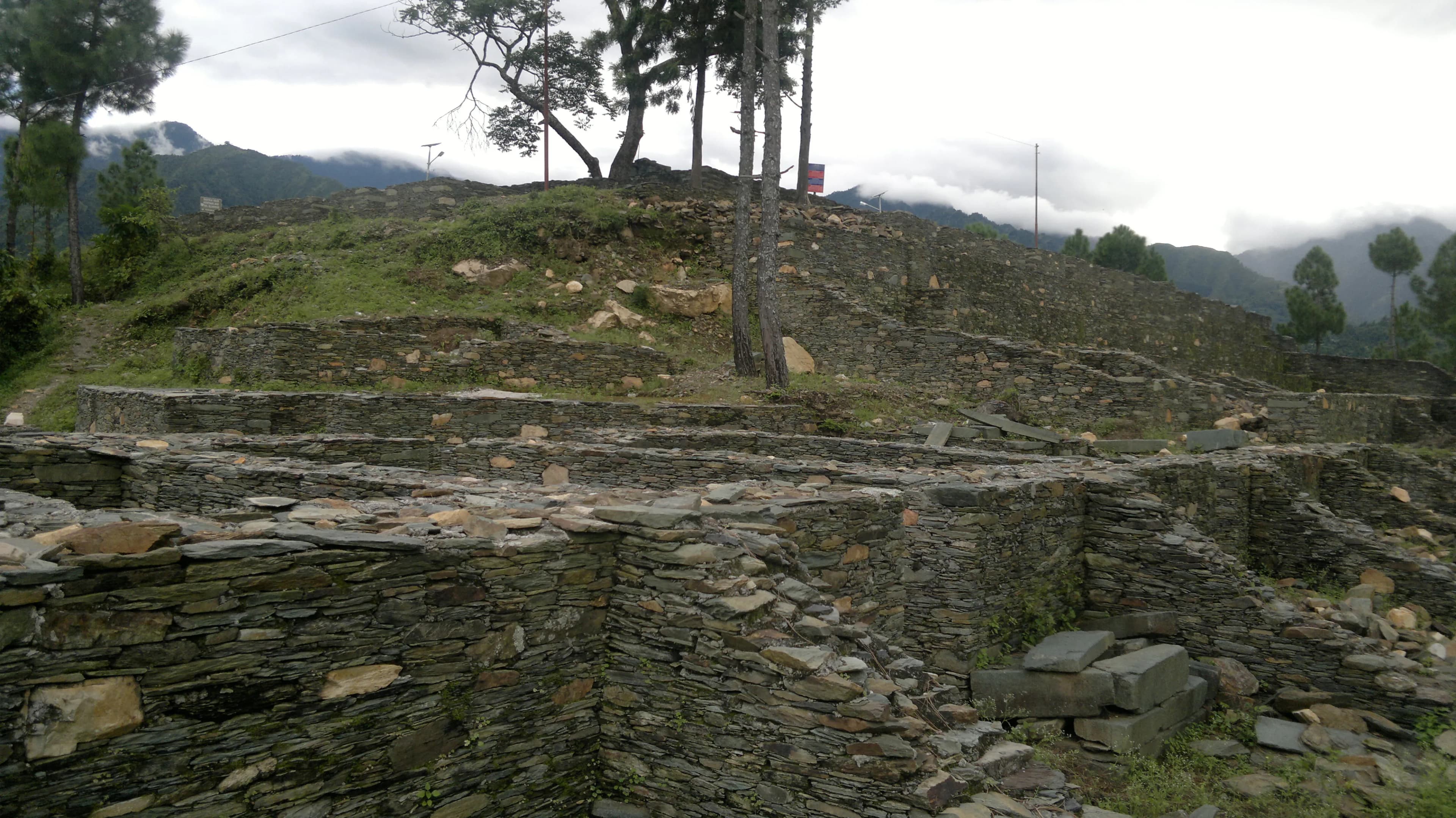
Featured
Chandpur Garhi, Tehri Garhwal, Narendranagar (249175), Uttarakhand, India, Uttarakhand
The wind whipped around me, carrying whispers of history as I stood atop Chandpur Garhi fort, gazing across the sprawling Tehri Garhwal landscape. The fort, a silent sentinel perched on a hilltop, commanded a breathtaking panorama of the Bhagirathi valley, a view that must have been strategically invaluable to its past rulers. It wasn't difficult to imagine the fort in its prime, bustling with activity, a formidable stronghold against invaders. My journey to Chandpur Garhi had been arduous, a winding climb up a steep, narrow road. But the first glimpse of the fort, its imposing ramparts silhouetted against the clear mountain sky, made the effort worthwhile. The fort, primarily constructed of locally quarried stone, displayed a rugged, almost organic architecture, blending seamlessly with the surrounding terrain. The stonework, though weathered by centuries of exposure, retained a remarkable integrity, a testament to the skill of the original builders. Entering the fort through a massive arched gateway, I was struck by the sheer scale of the complex. The interior was a labyrinth of interconnected courtyards, chambers, and passageways, each whispering tales of a bygone era. The remnants of residential quarters, stables, and storage areas spoke of a once thriving community within these walls. I noticed intricate carvings adorning some of the stonework, delicate floral patterns and geometric designs that hinted at a refined aesthetic sensibility. These details, often overlooked, provided a glimpse into the cultural richness of the fort's inhabitants. One of the most striking features of Chandpur Garhi is its intricate water management system. Several large cisterns, strategically placed within the complex, collected rainwater, ensuring a continuous supply for the fort's occupants. The ingenuity of this system, particularly in such a challenging environment, is truly remarkable. I spent considerable time photographing these cisterns, fascinated by their construction and the foresight they represented. The central courtyard, the heart of the fort, offered a panoramic view of the surrounding hills. Here, I could almost hear the echoes of past battles, the clash of swords, and the thunder of hooves. The strategic placement of the fort, offering clear lines of sight in all directions, underscored its military importance. I could visualize sentries patrolling the ramparts, ever vigilant against potential threats. As I explored further, I discovered a small, almost hidden temple dedicated to the local deity. The temple, though simple in its design, possessed a quiet serenity, a stark contrast to the martial atmosphere of the rest of the fort. The presence of this sacred space within the fort walls highlighted the importance of religious beliefs in the lives of the people who once lived here. The light began to fade, casting long shadows across the ancient stones. As I prepared to descend, I paused for one last look at Chandpur Garhi. The fort, bathed in the warm glow of the setting sun, seemed to exude a timeless aura, a tangible link to a rich and complex past. My time at Chandpur Garhi was more than just a photographic expedition; it was a journey through time, an immersive experience that allowed me to connect with the history and heritage of this remarkable place. The images I captured, I hope, will serve as a testament to the enduring legacy of Chandpur Garhi, a silent witness to the ebb and flow of history in the heart of the Himalayas. The fort stands not just as a testament to architectural ingenuity but as a poignant reminder of the power of place and the stories etched within its ancient stones. It is a place that deserves to be explored, understood, and preserved for generations to come.
Fort
Gurjara-Pratihara Period
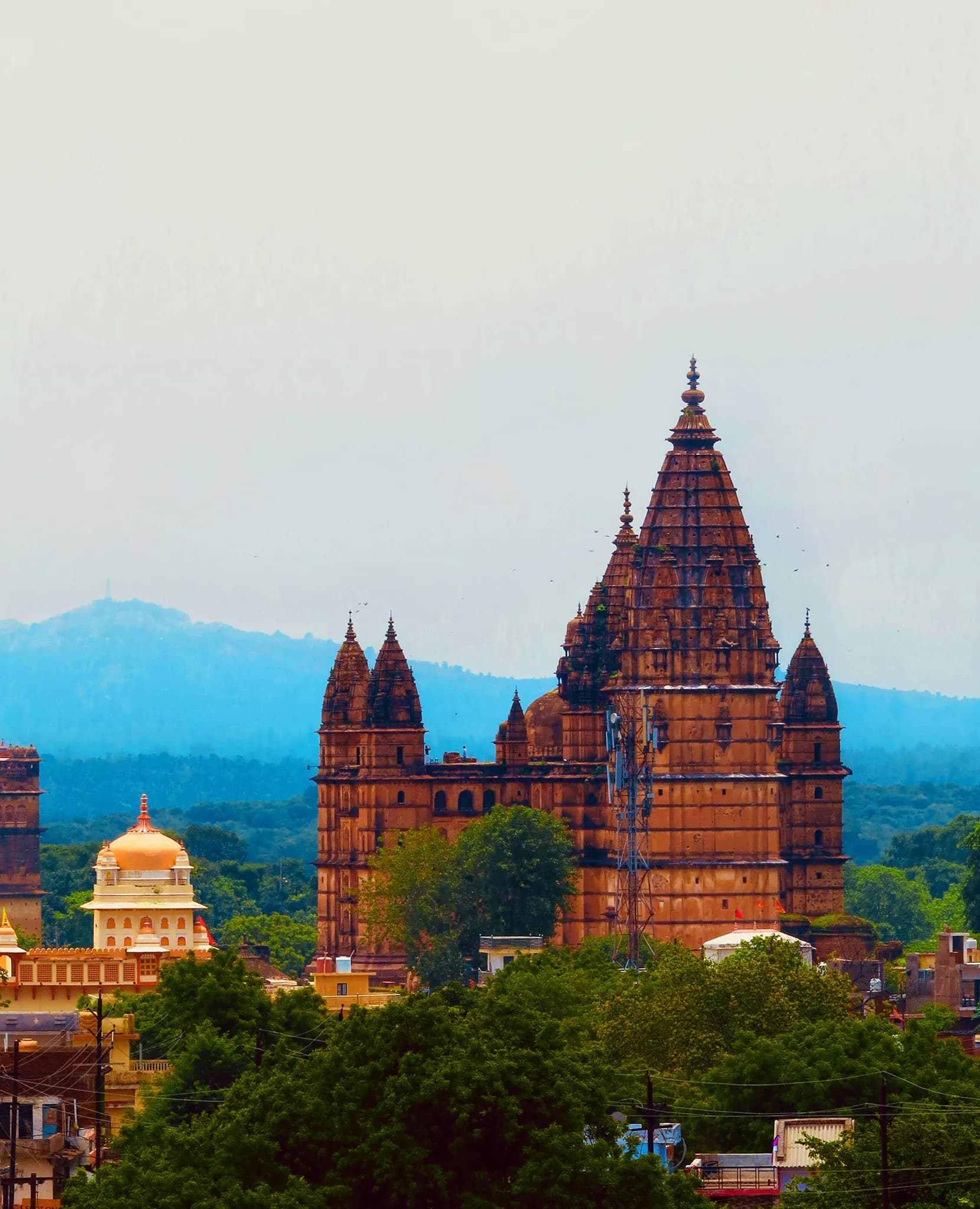
Featured
80% Documented
Palace Road, Niwari, Orchha (472246), Madhya Pradesh, India, Madhya Pradesh
The imposing silhouette of the Chaturbhuj Temple dominates the Orchha skyline. Rising from the heart of this medieval town in Madhya Pradesh, it presents a striking paradox – a grand temple dedicated to Lord Vishnu, yet seemingly devoid of the deity it was intended to house. My journey across India’s UNESCO World Heritage sites brought me to this architectural marvel, and the experience was nothing short of captivating. The temple’s exterior is a symphony in sandstone. Intricate carvings adorn every inch of the facade, depicting scenes from Hindu mythology, celestial beings, and floral motifs. The sheer scale of the structure is awe-inspiring. The tall shikharas, reminiscent of Bundela architecture, reach towards the heavens, their surfaces punctuated by delicate balconies and ornate windows. I spent a considerable amount of time simply circling the temple, absorbing the details. The play of light and shadow on the carved surfaces throughout the day created an ever-changing spectacle. The warm hues of the stone, kissed by the setting sun, etched a particularly memorable image in my mind. Ascending the steep, narrow staircase within the temple was an adventure in itself. The climb, though slightly arduous, was rewarded with panoramic views of Orchha and the surrounding countryside. From this vantage point, the strategic location of the temple within the fortified complex became evident. I could see the Betwa River meandering through the landscape, the Jahangir Mahal standing proudly in the distance, and the sprawling cenotaphs lining the riverbank. The interior of the Chaturbhuj Temple, however, presented a stark contrast to its ornate exterior. The vast, echoing halls were surprisingly bare. The absence of a presiding deity added to the sense of mystery. Local lore suggests that the idol of Lord Rama, originally intended for this temple, was installed in the Ram Raja Temple instead, leaving the Chaturbhuj Temple eternally waiting. This unexpected emptiness allowed me to focus on the architectural details of the interior. The high vaulted ceilings, the massive pillars supporting the structure, and the remnants of faded frescoes spoke volumes about the temple's history and the craftsmanship of the era. One element that particularly fascinated me was the intricate latticework adorning the windows. These jalis, carved from single pieces of stone, filtered the sunlight, creating mesmerizing patterns on the floor. I noticed how the designs varied from window to window, showcasing the skill and artistry of the craftsmen. Standing within these hallowed halls, I could almost hear the echoes of history whispering through the stones. The Chaturbhuj Temple is more than just a structure; it's a testament to the architectural prowess of the Bundela dynasty and a poignant reminder of the passage of time. The temple's unique story, coupled with its stunning architecture, makes it a must-see for anyone visiting Orchha. It’s a place where history, mythology, and artistry converge, leaving a lasting impression on the visitor. My experience at the Chaturbhuj Temple was a powerful reminder of the rich cultural heritage of India and the importance of preserving these architectural treasures for generations to come. It’s a place that stays with you long after you’ve left, prompting reflection on the stories etched within its walls.
Temple
Rajput Period
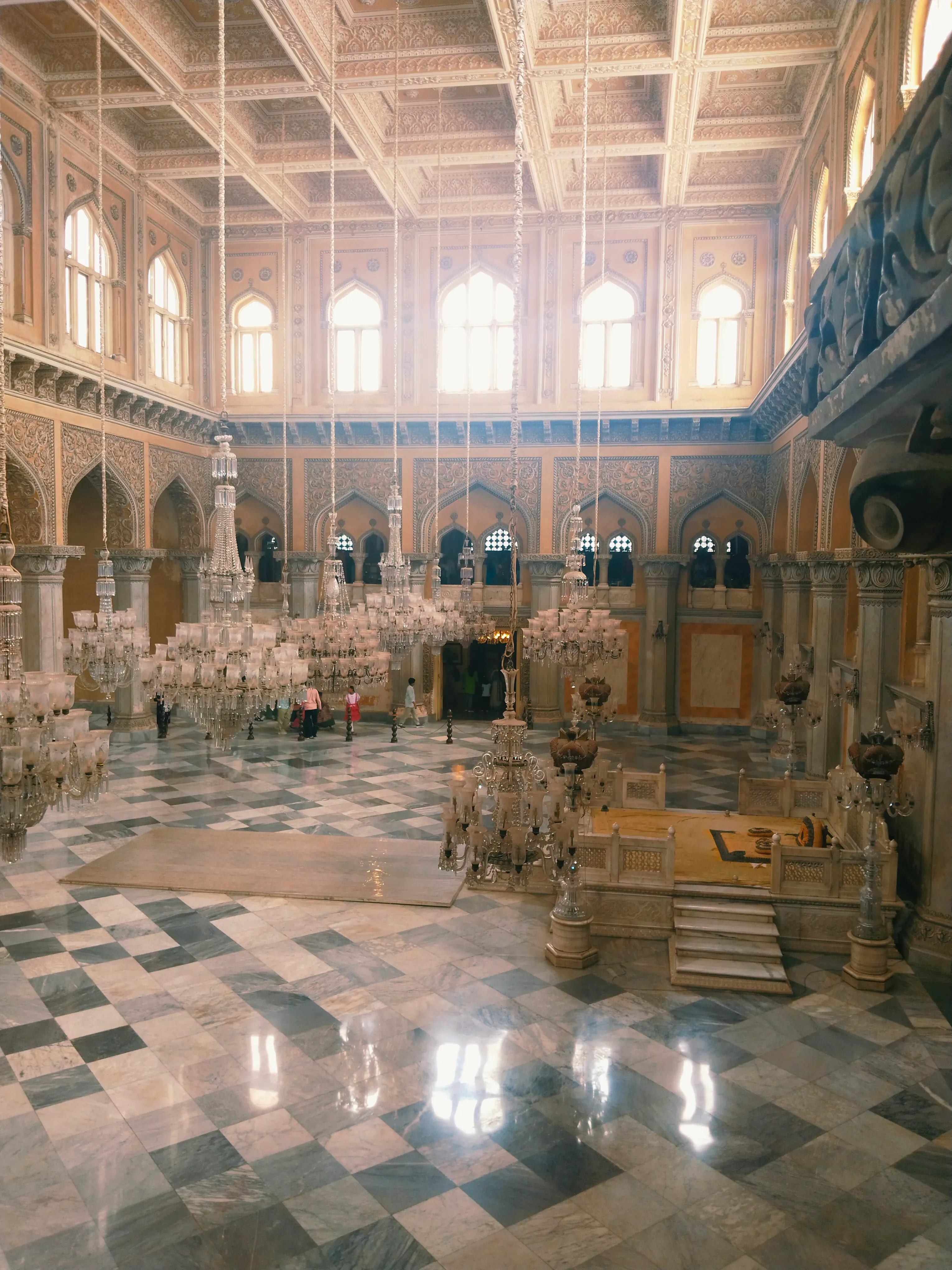
Featured
80% Documented
Khilwat, Hyderabad (500002), Telangana, India, Andhra Pradesh
The imposing Khilwat Clock Tower, its four clock faces gazing out over Hyderabad, was my first glimpse of Chowmahalla Palace. Having explored countless Rajput forts and palaces back home in Rajasthan, I was eager to see how the Nizami architecture of this southern royal residence would compare. Stepping through the main gate felt like crossing a threshold into another era. The cacophony of Hyderabad’s streets melted away, replaced by the quiet dignity of this sprawling complex. Chowmahalla, meaning “four palaces,” is a misnomer; it's more a network of palaces, courtyards, gardens, and halls, each with its own distinct character. The grandest of these is the Southern Courtyard, dominated by the Afzal Mahal. Its neoclassical facade, with its Corinthian columns and ornate stucco work, speaks to a clear European influence, a stark contrast to the Rajput architecture I’m so familiar with. The intricate jali work, however, whispered of a Mughal legacy, a subtle reminder of the intertwined histories of these dynasties. Inside the Afzal Mahal, the Durbar Hall took my breath away. Sunlight streamed through the Belgian crystal chandeliers, casting rainbows across the polished marble floor. I could almost picture the Nizam holding court here, surrounded by courtiers and dignitaries. The sheer opulence on display, from the intricately carved furniture to the priceless artifacts, was a testament to the immense wealth and power of the Asaf Jahi dynasty. Moving north, I entered the Bara Imam, a long, rectangular courtyard flanked by rows of rooms. Here, the architecture shifted again. The stucco gave way to exposed brick, and the European flourishes were replaced by simpler, more functional designs. This area, I learned, served as administrative offices and living quarters for palace officials. It offered a fascinating glimpse into the daily workings of the palace, beyond the grandeur of the royal court. The heart of Chowmahalla, however, lies in the Khilwat Mubarak. This exquisite palace, with its delicately carved arches and intricate stucco work, served as the ceremonial seat of the Nizams. The central fountain, its waters shimmering in the sunlight, created a sense of tranquility amidst the surrounding splendor. I spent a long time here, simply absorbing the atmosphere, trying to imagine the ceremonies and rituals that must have unfolded within these walls. The Clock Tower, my initial landmark, houses the oldest working clock in Hyderabad. Climbing its narrow stairs, I was rewarded with panoramic views of the palace complex and the city beyond. From this vantage point, the sheer scale of Chowmahalla became truly apparent. It wasn’t just a palace; it was a microcosm of a bygone era. One of the most striking aspects of Chowmahalla is the way it blends different architectural styles. The European influences are undeniable, yet they are seamlessly integrated with Mughal and local Deccani elements, creating a unique hybrid that reflects the cosmopolitan nature of Hyderabad itself. Unlike the imposing sandstone fortresses of Rajasthan, Chowmahalla exudes a more refined, almost delicate elegance. The intricate stucco work, the delicate jali screens, and the shimmering fountains all contribute to this sense of refined beauty. As I left Chowmahalla, I couldn’t help but compare it to the palaces I knew so well back home. While the Rajput forts and palaces of Rajasthan embody a rugged, martial grandeur, Chowmahalla possesses a more subtle, sophisticated charm. Both are testaments to the power and artistry of their respective rulers, but they express that power in vastly different ways. My visit to Chowmahalla was a reminder that India’s architectural heritage is incredibly diverse and that each region has its own unique story to tell.
Palace
British Colonial Period

Featured
80% Documented
Jaleb Chowk, Jaipur, Jaipur (302002), Rajasthan, India, Rajasthan
The City Palace of Jaipur isn't just a landmark; it's a living testament to Rajput grandeur, a story etched in sandstone and marble, unfolding within the very heart of the Pink City. I’ve walked these courtyards countless times, both as a journalist and a native of Rajasthan, yet each visit reveals a new nuance, a different whisper from the past. Passing through the Virendra Pol, the main entrance, the initial impression is one of organized chaos. Tourists throng the squares, their chatter mingling with the calls of vendors selling trinkets and textiles. But look beyond the bustling present, and the palace begins to speak. The architecture is a captivating blend of Rajput, Mughal, and European styles, a testament to the evolving influences that shaped Jaipur's history. Notice the delicate jali work, the intricate carvings adorning the archways, and the imposing façade of the Mubarak Mahal, a reception hall built with a fascinating fusion of Islamic, Rajput and European architectural styles. Its pastel façade, a delicate blend of pink and cream, seems to shimmer under the Rajasthan sun. My favorite part of the complex is the Pritam Niwas Chowk, a courtyard framed by four exquisitely decorated gates. Each gate represents a season and a Hindu god. The Virendra Pol, through which we entered, is dedicated to Lord Ganesha. Then there's the Udai Pol, celebrating Lord Vishnu and adorned with autumnal motifs; the Laxmi Pol, shimmering with silver and dedicated to the goddess of wealth, representing spring; and finally, the Leheriya Pol, a riot of peacock-themed decorations honoring Lord Shiva and summer. Standing in the center of the chowk, surrounded by this explosion of artistry, feels like being at the heart of a vibrant, living painting. Venturing further into the complex, I always find myself drawn to the Chandra Mahal, the current residence of the royal family. While a portion remains private, the sections open to the public offer a glimpse into the opulent lifestyle of the Maharajas. The Sukh Niwas, with its intricate floral decorations and cooling system using sandalwood doors and water channels, is a marvel of ingenuity. The Rang Mahal, with its stained glass windows and delicate mirror work, evokes a sense of ethereal beauty. Even the names of these chambers – Sukh Niwas (Hall of Pleasure), Shobha Niwas (Hall of Beauty) – speak volumes about the refined sensibilities of the royals. The Armoury, located within the palace complex, is another must-see. Here, rows upon rows of swords, daggers, and flintlock rifles stand as silent witnesses to Jaipur's martial history. The craftsmanship on display is breathtaking, from the intricately carved hilts of the swords to the inlaid designs on the armour. One can almost imagine the Maharajas and their warriors, clad in this very armour, riding into battle. Beyond the grandeur and opulence, the City Palace also offers quiet corners for contemplation. I often find myself wandering through the Bagghi Khana, the royal carriage museum, admiring the vintage vehicles, each a unique piece of art. The palanquins, elephant howdahs, and horse-drawn carriages tell tales of royal processions and journeys, offering a glimpse into a bygone era. As the sun begins to set, casting long shadows across the courtyards, the City Palace takes on a different kind of magic. The sandstone glows with a warm, honeyed hue, and the intricate carvings seem to deepen, revealing new details in the fading light. It's at this hour, with the crowds thinning and the city settling into a quieter rhythm, that the true spirit of the palace reveals itself – a timeless blend of history, artistry, and royal legacy, whispering secrets to those who take the time to listen. It's a place I've returned to countless times, and one I know I'll continue to visit, drawn back by its enduring charm and the stories it continues to tell.
Palace
Rajput Period
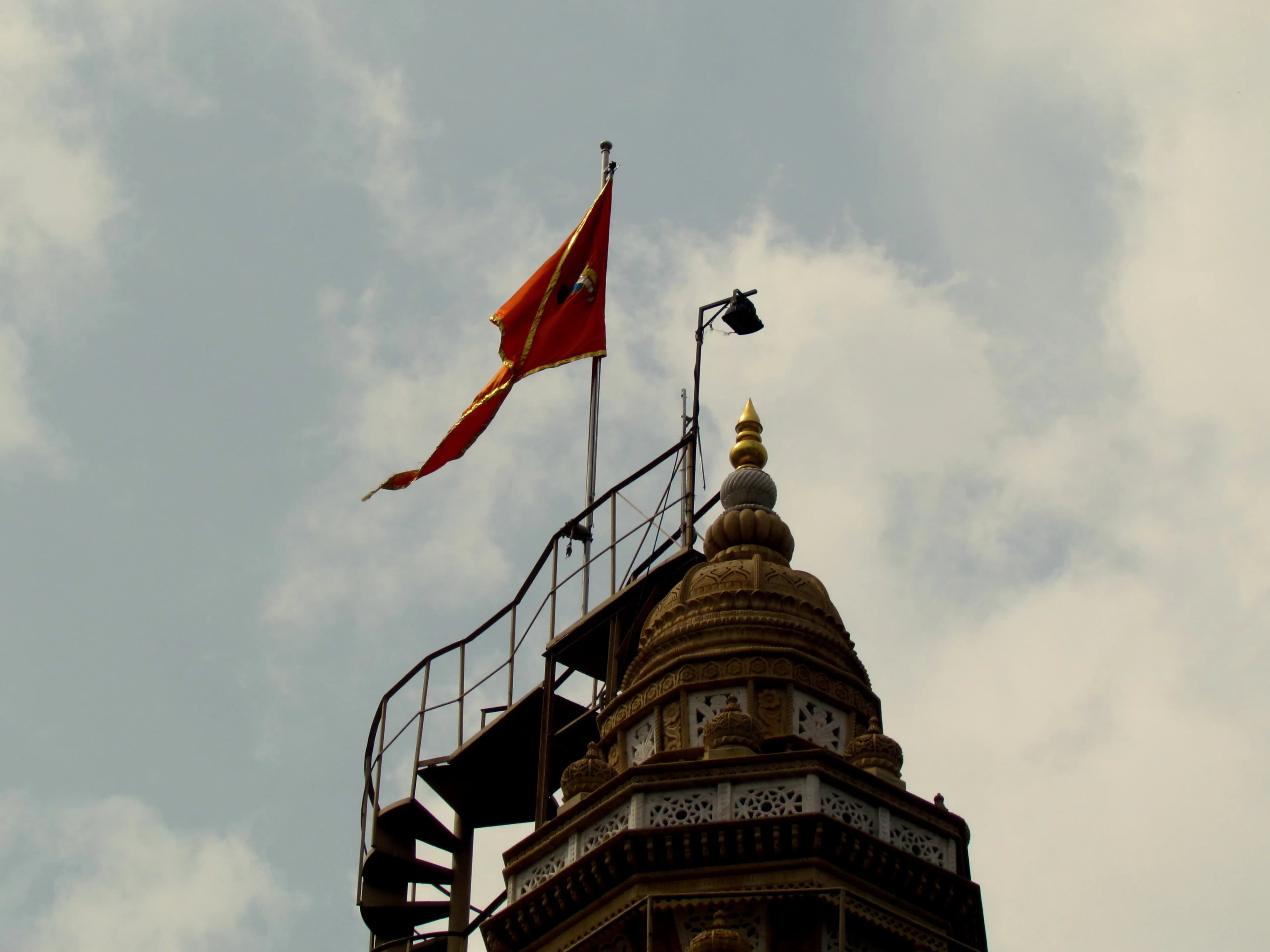
Featured
80% Documented
270, Budhwar Peth, Pune (411002), Maharashtra, India, Maharashtra
The air thrummed with a palpable energy, a blend of devotion and festive anticipation, as I stepped into the bustling square before the Dagdusheth Halwai Ganpati Temple. Having explored the intricate stone carvings of Gujarat's temples, I was eager to witness this Maharashtrian marvel, renowned for its grandeur and the rich history woven into its very fabric. The temple, dedicated to Lord Ganesha, immediately commanded attention. Its towering structure, a vibrant tapestry of ochre and saffron, seemed to pulsate with the heartbeats of the devotees thronging its entrance. The first thing that struck me was the sheer scale of the Ganesh idol housed within. Seven and a half feet tall and weighing over 100 kilograms, the deity, affectionately known as Dagdusheth, is a breathtaking spectacle. Crafted from pure gold, it radiated a warm, inviting glow, its bejeweled ornaments shimmering under the strategically placed lights. Unlike the serene, meditative depictions of Ganesha I'd encountered in Gujarat, this idol exuded a regal, almost kingly aura. It was easy to see why he was considered the reigning deity of Pune. The temple's architecture, though distinctly Maharashtrian, resonated with the ornate sensibilities I'd come to appreciate in Gujarati temple design. While Gujarat's temples often employ intricate carvings on sandstone, Dagdusheth Halwai Temple showcases a different kind of artistry. The multi-tiered shikhara, the towering structure above the sanctum sanctorum, was a marvel of modern construction, its vibrant colors a departure from the muted tones of ancient stone. Yet, the detailing, particularly around the pillars and doorways, echoed the meticulous craftsmanship I'd witnessed in Gujarat. Intricate floral motifs and depictions of mythological scenes adorned the surfaces, each telling a silent story. As I moved through the temple complex, I noticed the pervasive use of marble. The flooring, polished to a mirror sheen, reflected the vibrant colors of the devotees' sarees and the flickering flames of oil lamps. The pillars, too, were clad in marble, their smooth surfaces contrasting beautifully with the ornate gold work adorning the deity. This extensive use of marble, while less common in Gujarat's temples, lent the space an air of pristine elegance. The atmosphere within the temple was charged with devotion. The rhythmic chanting of mantras, the fragrance of incense, and the sea of faces uplifted in prayer created a powerful sensory experience. I observed families offering modaks, sweet offerings to the deity, a practice that resonated with the prasad offerings common in Gujarati temples. Despite the differences in architectural style and regional customs, the underlying current of faith and reverence felt universally familiar. What truly set Dagdusheth Halwai Ganpati Temple apart, however, was its connection to the community. Built by a successful sweet-maker, Dagdusheth Gadve, after losing his son to the plague, the temple stands as a testament to his resilience and devotion. This personal story, deeply embedded in the temple's history, resonated with the devotees, creating a palpable sense of connection and shared experience. I learned that the temple trust actively engages in social work, further strengthening its ties with the community. This aspect, the temple's role as a social hub, was something I hadn't encountered as prominently in Gujarat's temples. Leaving the temple, I carried with me not just the visual splendor of its architecture and the palpable devotion of its devotees, but also a deeper understanding of how faith can manifest in different forms, shaping not just individual lives but entire communities. The Dagdusheth Halwai Ganpati Temple, a vibrant testament to faith and resilience, stands as a unique landmark, showcasing the rich tapestry of Indian spirituality and architecture.
Temple
British Colonial Period
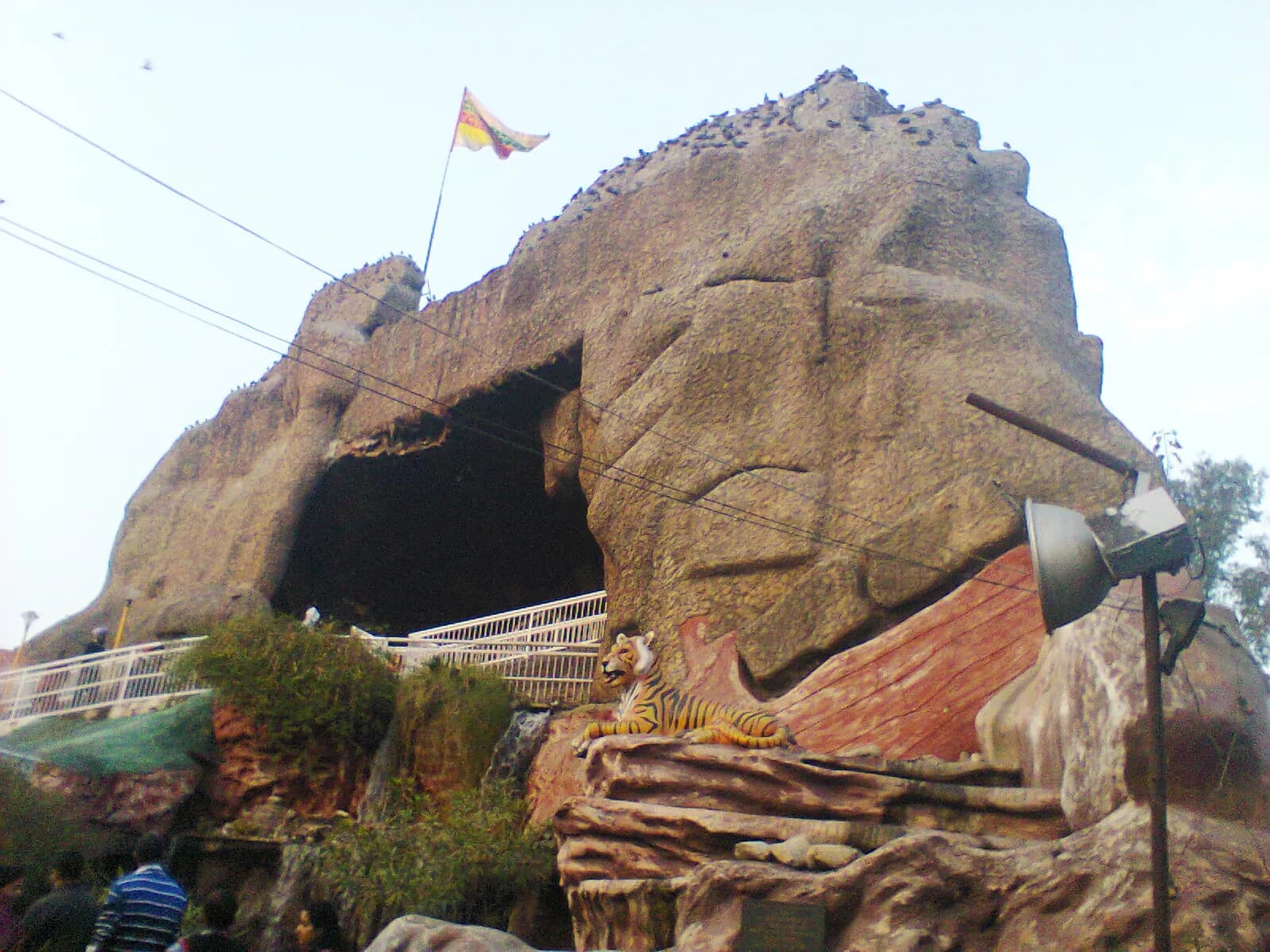
Featured
80% Documented
Devi Talab Road, Jalandhar, Jalandhar (144001), Punjab, India, Punjab
The winter sun, a pale disc in the Jalandhar sky, cast long shadows across the sprawling Devi Talab Mandir complex. The air, crisp and carrying the scent of incense, vibrated with a low hum of devotional chants. This wasn't just another temple on my 500+ monument documentation journey; Devi Talab Mandir held a different energy, a palpable sense of history layered beneath its contemporary renovations. The first thing that struck me wasn't the main temple, but the expansive tank, or 'talab,' that gives the site its name. Surrounded by a colonnaded walkway, the still water mirrored the ornate structures around it, creating a mesmerizing visual symphony. Local lore links this tank to the ancient Saptsar Sarovar, mentioned in the Mahabharata, lending the site a mythical aura that transcends its documented history. I spent a good hour circling the tank, my camera capturing the interplay of light and shadow on the water, the devotees performing their rituals, and the pigeons taking flight in startled bursts. The main temple, dedicated to Goddess Durga, stands on an island in the center of the tank, accessible by a decorative bridge. Its architecture is a fascinating blend of traditional and modern elements. While the core structure retains its ancient essence, evident in the intricate carvings and the use of red sandstone, the recent renovations have added a layer of gleaming marble and gold plating. This juxtaposition, while jarring at first, grew on me. It spoke of the continuous evolution of faith and the adaptation of sacred spaces across time. Inside the sanctum, the atmosphere was thick with devotion. The air was heavy with the fragrance of flowers and the flickering lamps cast an ethereal glow on the deity. Photography wasn't permitted inside, but the image of the serene goddess, adorned in vibrant silks and jewels, stayed etched in my memory. I observed the rituals, the fervent prayers, and the quiet reverence of the devotees, each interacting with the divine in their own unique way. Beyond the main shrine, the complex houses several smaller temples dedicated to various deities. Each shrine, though smaller in scale, boasted its own distinct architectural character. I was particularly drawn to the Hanuman temple, its vibrant red facade a stark contrast to the muted tones of the surrounding structures. The intricate carvings depicting scenes from the Ramayana were a testament to the skill of the artisans who had painstakingly created them. One of the most captivating aspects of Devi Talab Mandir was its integration with the surrounding urban landscape. Unlike many ancient temples that are isolated from the bustle of city life, this temple seemed to embrace it. The constant flow of devotees, the vendors selling religious paraphernalia, and the sounds of the city filtering in created a unique atmosphere, a blend of the sacred and the secular. As I prepared to leave, I climbed to the top of a nearby building to capture a panoramic view of the complex. From this vantage point, the temple, the tank, and the surrounding city spread out before me like a tapestry woven with threads of history, faith, and human endeavor. Devi Talab Mandir wasn't just a collection of beautiful structures; it was a living, breathing testament to the enduring power of belief and the continuous evolution of sacred spaces. It was a place where the past and the present intertwined, creating a unique narrative that resonated deep within me long after I had left its hallowed grounds.
Temple
Sikh Period
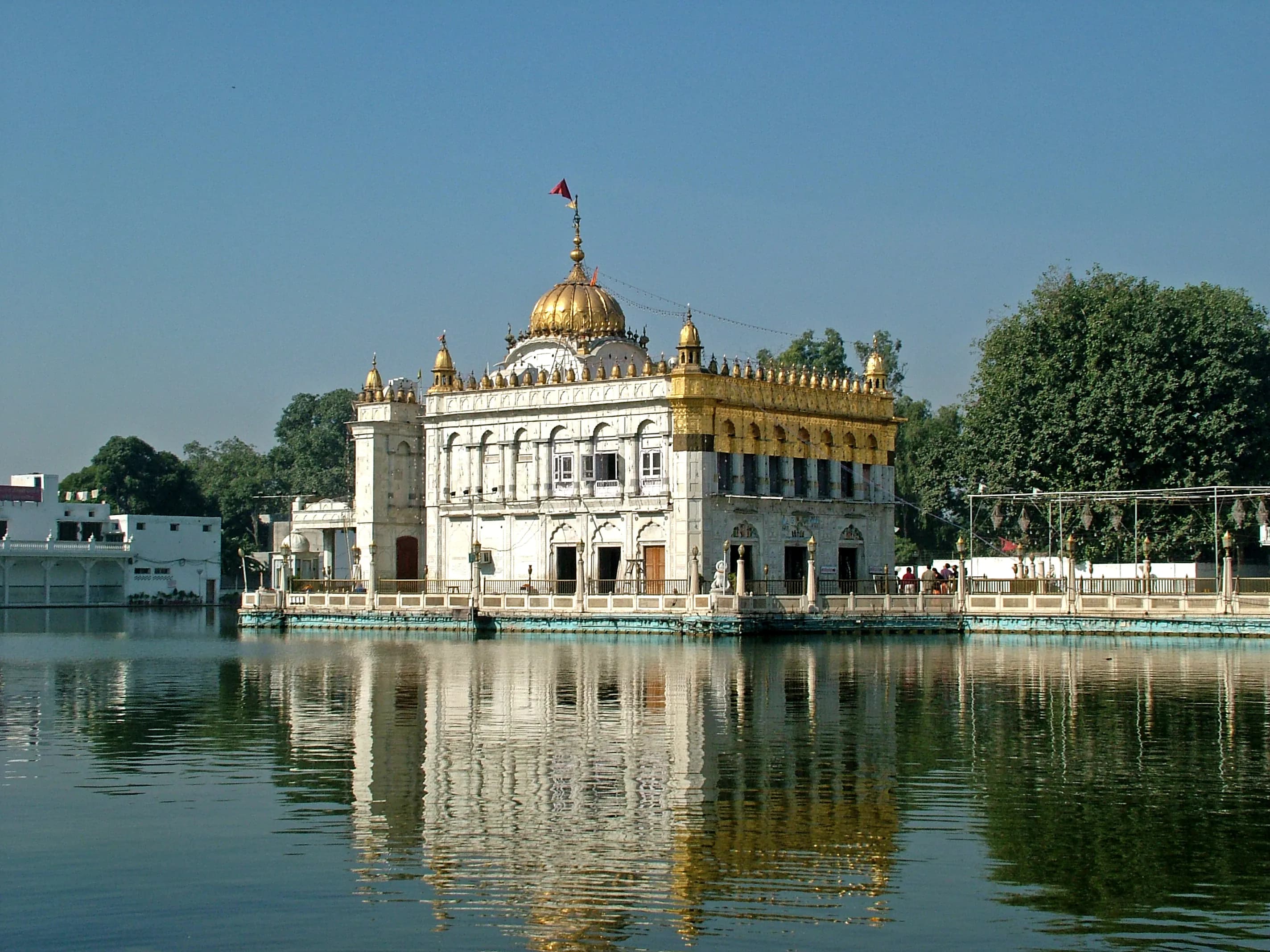
Featured
80% Documented
Hathi Gate, Amritsar, Amritsar (143006), Punjab, India, Punjab
The shimmering gold of Durgiana Temple, nestled within the bustling heart of Amritsar, almost startled me. Having spent years immersed in the sandstone and terracotta hues of Uttar Pradesh's temples, this explosion of gilded splendour felt like stepping into a different world. Known as the Lakshmi Narayan Temple, and often referred to as the "Silver Temple" due to its intricately carved silver doors, Durgiana Temple stands as a testament to the syncretic nature of Indian spirituality. While its architecture distinctly echoes the Sikh Harmandir Sahib, the deities enshrined within are Hindu, creating a fascinating blend of influences. The temple is situated on an island in the middle of a sacred tank, accessed by a bridge much like its more famous golden counterpart. The approach itself is a sensory experience. The air hums with devotional chants, the scent of incense hangs heavy, and the vibrant colours of marigold garlands and devotees’ clothing create a kaleidoscope against the white marble of the pathway. As I crossed the bridge, the full magnificence of the temple unfolded before me. The multi-storied structure, crowned with multiple ornate domes, glittered under the afternoon sun. The intricate carvings covering every inch of the facade, depicting scenes from Hindu mythology, were breathtaking. I noticed a distinct Mughal influence in the cusped arches and decorative motifs, a reminder of the region's layered history. Entering the main sanctum, I was struck by the relative quiet compared to the bustling courtyard. The air was thick with the fragrance of sandalwood and flowers. The main deities, Lakshmi and Narayan, resided in their ornate silver shrine, bathed in the soft glow of oil lamps. The reverence of the devotees, their whispered prayers and offerings, created a palpable sense of sanctity. Unlike the prescribed circumambulatory path of many temples, here, devotees moved freely, finding their own spaces for prayer and contemplation. This fluidity felt unique and somehow more personal. I spent some time observing the intricate silver work on the doors. The panels depicted scenes from the Ramayana and Mahabharata, each figure meticulously crafted. The level of detail was astonishing, a testament to the skill of the artisans. The silver, though tarnished in places by time and touch, still held a captivating lustre. It was easy to see why the temple earned its moniker, the "Silver Temple." Beyond the main shrine, the temple complex houses smaller shrines dedicated to various deities, including Lord Hanuman and Ma Durga, the temple's namesake. Each shrine had its own distinct character, adorned with specific colours and iconography. I was particularly drawn to the shrine of Ma Durga, tucked away in a quieter corner. The vibrant red and orange hues, symbolic of the goddess’s power, created a stark contrast to the predominantly gold and silver palette of the main temple. As I circumambulated the tank, I observed the diverse crowd of devotees. Sikhs, Hindus, and even some tourists mingled seamlessly, united in their reverence for the sacred space. This intermingling of faiths, this shared sense of devotion, felt deeply resonant with the spirit of Amritsar, a city known for its inclusivity and communal harmony. It struck me that Durgiana Temple, while architecturally reminiscent of the Harmandir Sahib, was more than just a "Hindu Golden Temple." It was a symbol of the region's unique cultural tapestry, a place where different faiths could coexist and even find common ground. Leaving the temple, I carried with me not just the visual splendour of its gilded domes and silver doors, but also a deeper understanding of the nuanced religious landscape of Punjab. Durgiana Temple stands as a powerful reminder that spirituality, in its truest form, transcends the boundaries of defined religious labels. It is a testament to the shared human desire for connection, for meaning, and for the divine.
Temple
Sikh Period
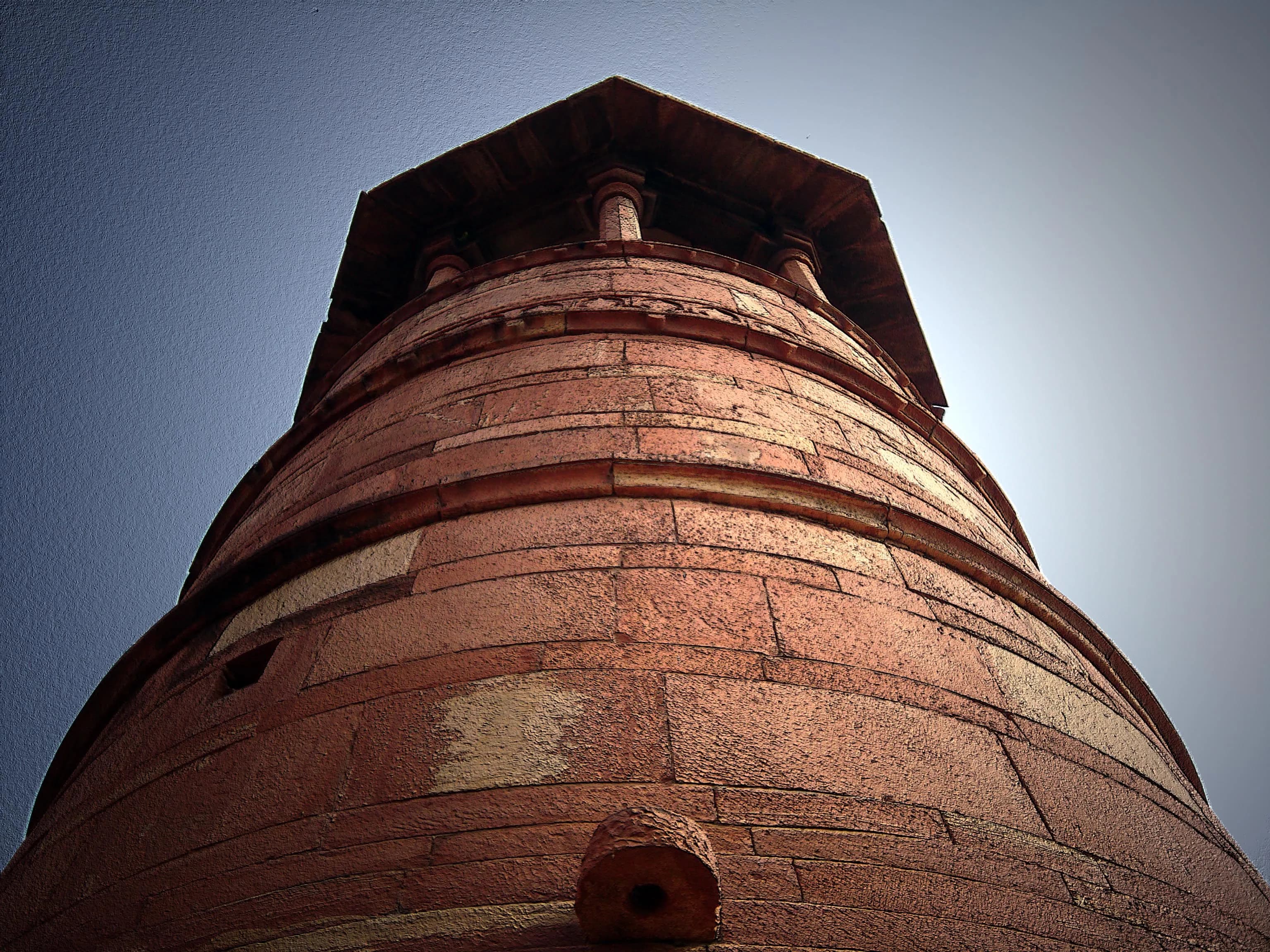
UNESCO
Featured
80% Documented
Fatehpur Sikri, Agra, Agra (283110), Uttar Pradesh, India, Uttar Pradesh
The sandstone shimmered under the late afternoon sun, a warm, almost ethereal glow bathing the deserted courtyards of Fatehpur Sikri. Having crisscrossed North India for years, exploring crumbling forts and bustling cities, I thought I was immune to the charms of another Mughal monument. I was wrong. Fatehpur Sikri, Akbar’s abandoned capital, whispered stories of a glorious past, a brief but brilliant chapter in Indian history. Stepping through the Buland Darwaza, the imposing victory gate, felt like stepping back in time. Its sheer scale is breathtaking, a 54-meter high testament to Akbar’s military prowess. The intricate carvings, a blend of Persian and Indian motifs, hinted at the cultural confluence that defined his reign. This wasn't just a fort; it was a city, meticulously planned and executed, a testament to a vision that, though short-lived, left an indelible mark. The Diwan-i-Aam, the hall of public audience, sprawled before me, its vastness punctuated by the raised platform where Akbar, the emperor, would address his subjects. I could almost picture the vibrant scene – the courtiers, the petitioners, the bustling activity of a thriving capital. The Diwan-i-Khas, the hall of private audience, was even more captivating. The central pillar, intricately carved and radiating outwards like the branches of a tree, is an architectural marvel. It was here that Akbar held discussions with scholars and representatives of different faiths, fostering the spirit of religious tolerance that characterized his rule. I wandered through the Panch Mahal, a five-storied pavilion, each level smaller than the one below, creating a pyramidal structure that offered stunning views of the surrounding plains. The intricate jalis, or perforated stone screens, allowed the breeze to flow through, a clever architectural solution to the scorching summer heat. These screens also served another purpose – they allowed the royal women to observe the court proceedings without being seen, a glimpse into the secluded world of the Mughal zenana. The Jodhabai’s Palace, with its Hindu architectural influences, stood in stark contrast to the predominantly Persian style of the other buildings. The carved brackets, reminiscent of Rajput architecture, and the absence of the characteristic Mughal arches, spoke volumes about Akbar’s respect for his Hindu wife and his efforts to integrate different cultural elements into his empire. One of the most poignant structures within the complex is Salim Chishti’s tomb. The white marble mausoleum, a masterpiece of intricate carving, is a place of reverence even today. I watched as devotees tied threads to the marble screens, whispering prayers, their faith echoing through the centuries. It was here, according to legend, that Akbar came to pray for an heir, and the birth of his son, Jahangir, cemented the saint’s reputation and led to the construction of this magnificent tomb. As the sun began to set, casting long shadows across the deserted courtyards, I felt a sense of melancholy wash over me. Fatehpur Sikri, once a bustling metropolis, now stands silent, a ghost of its former glory. The reasons for its abandonment remain shrouded in mystery, with theories ranging from water scarcity to Akbar’s shifting political priorities. Whatever the reason, the silence that now pervades this magnificent city only amplifies the whispers of its past, making the experience all the more profound. Leaving Fatehpur Sikri, I carried with me not just photographs and memories, but a deeper understanding of a pivotal period in Indian history, a time of cultural fusion, religious tolerance, and architectural brilliance.
Fort
Mughal Rajput Period

Featured
80% Documented
Old Cantt Road, Amritsar, Amritsar (143006), Punjab, India, Punjab
The imposing red sandstone walls of Gobindgarh Fort rose before me, a stark contrast to the bustling, vibrant city of Amritsar that lay just beyond its gates. Having explored numerous Mughal and Rajput forts across Uttar Pradesh, I was eager to experience this Sikh stronghold, a testament to a different era and a distinct architectural style. The sheer scale of the fort, spread across 43 acres, was immediately impressive. It felt less like a single structure and more like a fortified city, a self-contained world within Amritsar. Entering through the Nalwa Gate, named after the legendary Sikh general Hari Singh Nalwa, I was struck by the blend of robustness and elegance. The fortifications, clearly designed with defense in mind, were not devoid of aesthetic considerations. The arched gateway, the intricate carvings around the wooden doors, and the strategically placed bastions all spoke of a meticulous approach to construction. Unlike the ornate embellishments I've seen in Rajasthani forts, Gobindgarh displayed a more restrained grandeur. The focus here seemed to be on strength and functionality, reflecting the martial ethos of the Sikh empire. The Toshakhana, the royal treasury, was my next stop. The sheer thickness of its walls, almost 12 feet in some places, underscored its importance. Inside, the cool air and dimly lit interiors created an atmosphere of hushed reverence. Imagining the wealth that once filled these vaults, from gold coins to precious jewels, gave me a tangible connection to the fort's opulent past. The displays of ancient weaponry, including swords, shields, and even a replica of the legendary Zamzama cannon (the original resides in Lahore), further emphasized the fort's military significance. Walking along the ramparts, I could see the city of Amritsar spread out like a tapestry below. The Golden Temple, gleaming in the distance, served as a poignant reminder of the spiritual heart of Sikhism, so closely intertwined with the fort's history. It was from this very fort that Maharaja Ranjit Singh, the Lion of Punjab, ruled his vast empire. Standing there, I could almost feel the weight of history, the echoes of marching soldiers and the whispers of courtly intrigues. The Darbar Hall, the seat of Maharaja Ranjit Singh's court, was particularly captivating. While the original structure was destroyed during the British occupation, the restored hall attempts to recapture its former glory. The ornate chandeliers, the vibrant frescoes depicting scenes from Sikh history, and the imposing throne all contribute to a sense of regal splendor. However, I couldn't help but feel a tinge of sadness, knowing that this was a recreation, a pale imitation of the original. One of the most engaging aspects of Gobindgarh Fort is its use of technology to bring history to life. The 7D show, projected onto a water screen, vividly portrays the story of the Koh-i-Noor diamond and its connection to the fort. While some might consider it a bit theatrical, I found it to be an effective way to engage visitors, especially younger generations, with the fort's rich past. The Whispering Walls light and sound show, projected onto the fort walls after sunset, is another example of this innovative approach. As I left the fort, passing once again through the Nalwa Gate, I felt a sense of awe and respect for the legacy of Maharaja Ranjit Singh and the Sikh empire. Gobindgarh Fort is not just a collection of buildings; it is a living testament to a vibrant culture, a symbol of resilience and a powerful reminder of a bygone era. It stands as a proud sentinel, guarding the memories of a glorious past while embracing the promise of a dynamic future. It offers a unique perspective, distinct from the Mughal grandeur I'm accustomed to in Uttar Pradesh, and provides valuable insights into the architectural and cultural landscape of Punjab.
Fort
Sikh Period
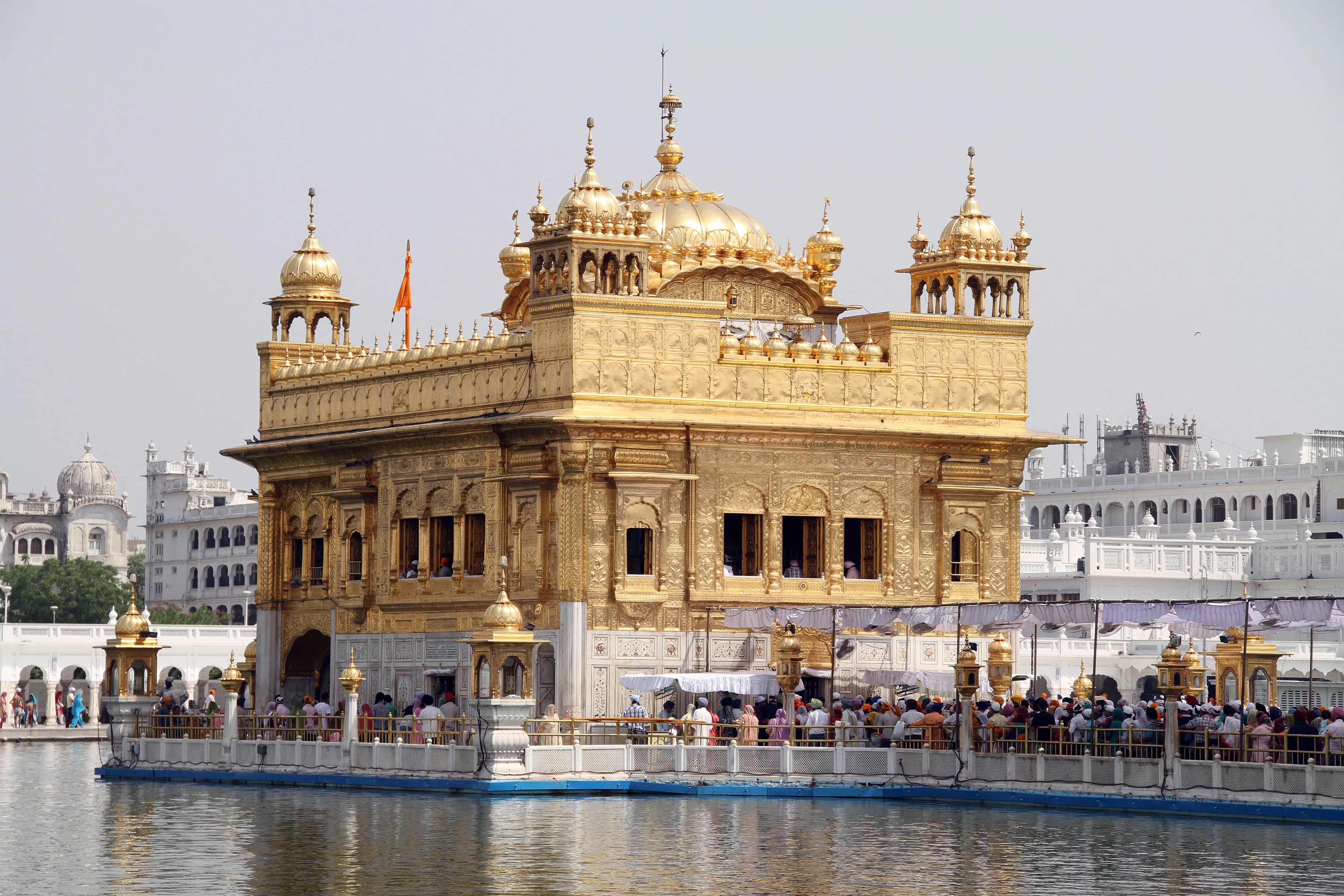
Featured
80% Documented
Golden Temple Road, Amritsar, Amritsar (143001), Punjab, India, Punjab
The shimmering reflection of the Golden Temple, or Sri Harmandir Sahib as it’s reverently called, in the Amrit Sarovar (Pool of Nectar) is an image that sears itself onto your soul. As a cultural journalist from Uttar Pradesh, I’ve witnessed countless expressions of faith across North India, but the serene spirituality of this Sikh gurudwara is unlike anything I’ve encountered. Stepping onto the marble parikrama, the circumambulatory path that encircles the temple, felt like entering a realm detached from the bustling city of Amritsar just beyond its walls. The architecture is a breathtaking blend of Mughal and Rajput influences, a testament to the syncretic nature of the region's history. The white marble platform, intricately inlaid with pietra dura work featuring floral motifs and geometric patterns, provides a stark yet harmonious contrast to the gilded superstructure. The gold plating, added later by Maharaja Ranjit Singh, shimmers brilliantly, especially as the sun begins its descent, casting a warm glow across the complex. The central dome, reminiscent of a lotus flower, is crowned with a chhatri, a small, ornate pavilion, a common feature in Rajput architecture. This fusion of styles speaks volumes about the cultural exchange and artistic patronage that flourished in Punjab. The constant chanting of hymns, the Gurbani, emanating from within the temple, creates an atmosphere of meditative tranquility. I observed devotees from all walks of life, Sikhs and non-Sikhs alike, circumambulating the holy tank with folded hands, their faces etched with devotion. The air hummed with a palpable sense of reverence, a collective energy of faith that transcended language and background. It was fascinating to witness the seva, the selfless service, performed by volunteers. From cleaning the floors to serving langar, the free community kitchen, everyone contributed, reinforcing the Sikh principles of equality and community. The langar itself is a remarkable experience. Thousands are fed daily, regardless of caste, creed, or social status. Sitting cross-legged on the floor alongside strangers, sharing a simple yet delicious meal, fostered a sense of unity and shared humanity. The sheer scale of the operation and the seamless efficiency with which it’s managed are truly impressive. It’s a powerful embodiment of the Sikh philosophy of Vand Chhako, sharing with others and consuming together. Inside the Harmandir Sahib, the atmosphere is even more charged with spirituality. The Guru Granth Sahib, the holy scripture of Sikhism, is placed on a raised platform under a richly embroidered canopy. The Granthi, the ceremonial reader, recites the verses with a melodic resonance that fills the sanctum. The air is thick with the scent of incense and the murmur of prayers. It’s a space that invites introspection and contemplation, a sanctuary for the soul. As I exited the complex, crossing the threshold back into the vibrant city life, I carried with me a profound sense of peace and a renewed appreciation for the power of faith. The Golden Temple isn't just a stunning architectural marvel; it’s a living testament to the enduring principles of equality, service, and devotion. It’s a place where the divine and the human intersect, creating an experience that is both deeply personal and universally resonant. The memory of the golden reflection shimmering in the holy waters, a beacon of hope and spirituality, will undoubtedly stay with me for years to come. It's a testament to the rich tapestry of India’s spiritual heritage, a story I, as a cultural journalist, feel privileged to have witnessed and shared.
Temple
Sikh Period

Featured
80% Documented
Jai Niwas Garden, Jaipur (302004), Rajasthan, India, Rajasthan
The Govind Dev Ji Temple in Jaipur isn't just a place of worship; it's a living testament to a unique blend of architectural styles that captivated me from the moment I stepped within its precincts. Having spent years studying the Dravidian architecture of South Indian temples, I was eager to experience the distinct architectural vocabulary of this North Indian shrine, and I wasn't disappointed. Located within the City Palace complex, the temple almost feels like a private sanctuary for the royal family, a feeling amplified by its relatively modest exterior compared to the grandeur of the surrounding palace buildings. The first thing that struck me was the absence of the towering gopurams that define South Indian temple gateways. Instead, the entrance is marked by a series of chhatris, elevated, dome-shaped pavilions supported by ornate pillars. These chhatris, with their delicate carvings and graceful curves, speak to the Rajput influence, a stark contrast to the pyramidal vimanas of the South. The use of red sandstone, a hallmark of Rajasthani architecture, lends the temple a warm, earthy hue, quite different from the granite and sandstone palettes I'm accustomed to seeing in Tamil Nadu. As I moved through the courtyard, I observed the seven-storied structure housing the main shrine. While not a gopuram in the traditional sense, it does serve a similar function, drawing the eye upwards towards the heavens. The multiple stories, each adorned with arched openings and intricate jali work, create a sense of verticality and lightness, a departure from the solid mass of South Indian temple towers. The jalis, or perforated stone screens, not only serve as decorative elements but also allow for natural ventilation, a practical consideration in the arid climate of Rajasthan. The main sanctum, where the image of Govind Dev Ji (Krishna) resides, is a relatively simple chamber, its focus squarely on the deity. The absence of elaborate sculptures on the walls within the sanctum surprised me. South Indian temples often feature intricate carvings depicting mythological scenes and deities on every available surface. Here, the emphasis is on the devotional experience, a direct connection with the divine, unmediated by elaborate ornamentation. The silver-plated doors of the sanctum, however, are exquisitely crafted, showcasing the artistry of the region's metalworkers. The courtyard itself is a marvel of spatial planning. The open space allows for the free flow of devotees, while the surrounding colonnades provide shade and a sense of enclosure. The pillars supporting these colonnades are slender and elegant, adorned with intricate floral motifs and geometric patterns. I noticed a distinct Mughal influence in some of these decorative elements, a testament to the cultural exchange that shaped the region's artistic traditions. The use of marble for flooring, another Mughal influence, adds a touch of opulence to the space. One of the most captivating aspects of the Govind Dev Ji Temple is its integration with the City Palace. The temple's location within the palace complex blurs the lines between the sacred and the secular, reflecting the close relationship between the royal family and the deity. This integration is a departure from the South Indian tradition where temples, while often patronized by royalty, maintain a distinct identity as separate entities. My visit to the Govind Dev Ji Temple was a fascinating cross-cultural experience. It highlighted the diversity of India's architectural heritage and underscored the power of architecture to reflect regional identities and religious beliefs. While the temple's architectural vocabulary differed significantly from the Dravidian style I'm familiar with, the underlying spirit of devotion and the artistic skill evident in its construction resonated deeply with my understanding of sacred architecture.
Temple
Rajput Period
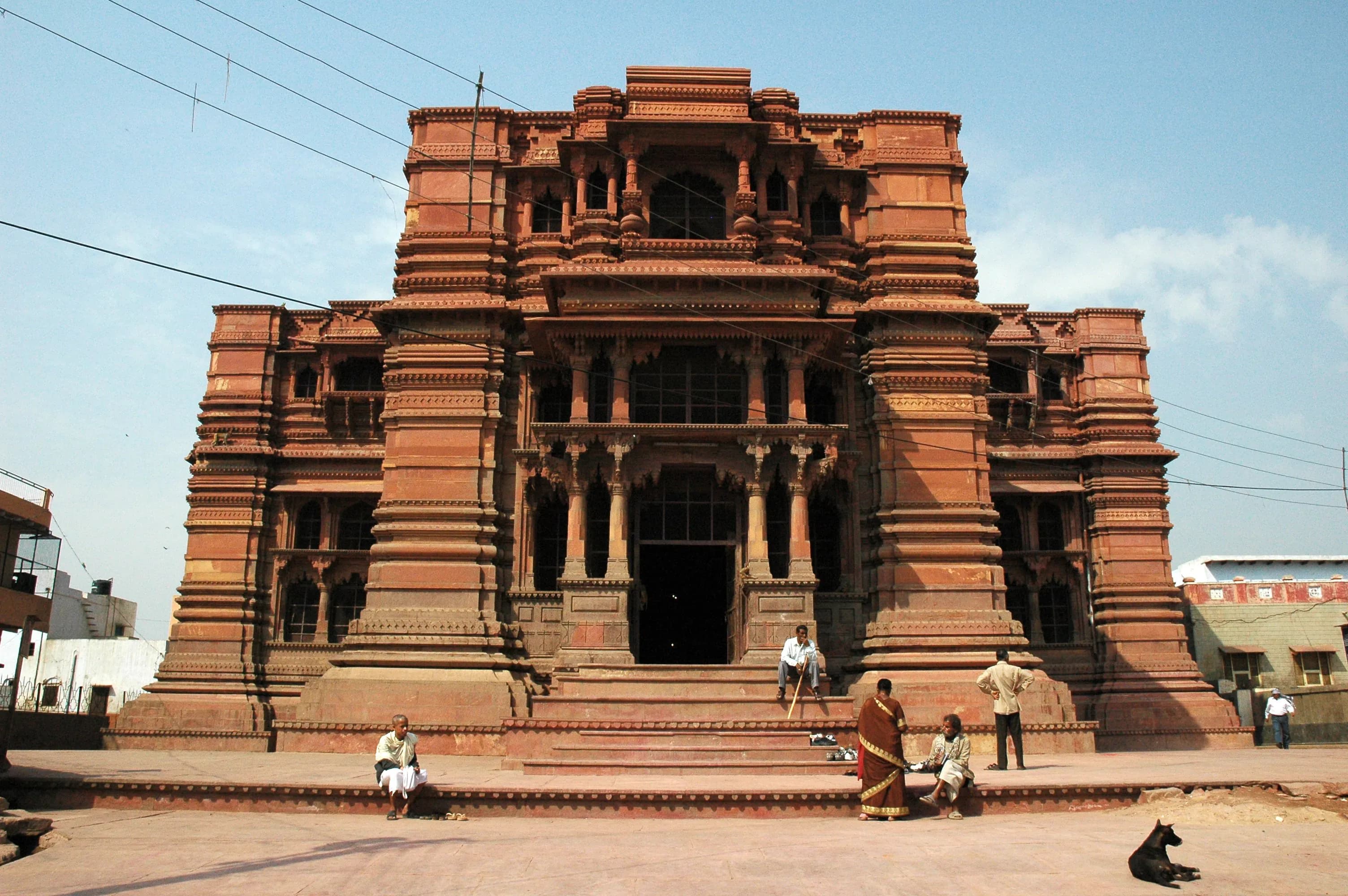
Featured
80% Documented
Near Loi Bazaar, Mathura, Vrindavan (281121), Uttar Pradesh, India, Uttar Pradesh
The red sandstone glowed, almost humming with a palpable energy under the late afternoon sun. Govind Dev Temple in Vrindavan, though no longer in its complete glory, still exudes a majestic aura that transported me back to a Vrindavan of centuries past. Having documented Gujarat's intricate temples for years, I was eager to experience the architectural nuances of this Braj marvel, and I wasn't disappointed. The first thing that struck me was the unique blend of architectural styles. While the temple’s core exhibits a distinctly Rajput influence, reminiscent of some of the grand structures I’ve seen in Rajasthan, the seven-storied structure (now sadly reduced to three) bore a striking resemblance to European architecture, particularly reminiscent of a cathedral. This fusion, I learned, was a result of the Mughal emperor Akbar's relatively tolerant religious policies during the late 16th century, a period that allowed for such cross-cultural architectural experimentation. Stepping inside the pillared hall, which now serves as the main prayer area, I was immediately drawn upwards. The soaring ceilings, even in their truncated state, evoked a sense of grandeur. The intricate carvings on the remaining pillars, depicting scenes from Krishna's life, were a testament to the skill of the artisans. Each carving told a story, each curve and line imbued with devotion. I spent a considerable amount of time tracing these narratives with my fingers, imagining the temple in its original seven-storied splendor. The absence of the upper four stories, destroyed by Aurangzeb in the 17th century, is a poignant reminder of the tumultuous history this temple has witnessed. Yet, the resilience of the structure and the continued devotion of the pilgrims who throng its courtyard speak volumes about its enduring spiritual significance. The air vibrated with chants and the fragrance of incense, creating an atmosphere thick with reverence. The temple complex is built around a rectangular courtyard, and while the main shrine is dedicated to Govind Dev (Krishna), smaller shrines dedicated to Radha and other deities dot the periphery. I observed the local devotees engaging in various rituals, their faces reflecting a deep connection to the divine. The rhythmic clang of bells and the melodic chanting of hymns further intensified the spiritual ambiance. The use of red sandstone, a material I'm intimately familiar with from Gujarat's architectural heritage, lends the temple a warm, earthy hue. However, unlike the intricate, almost lace-like carvings often seen in Gujarati temples, the carvings here are bolder, more pronounced, reflecting a different aesthetic sensibility. The interplay of light and shadow on the sandstone surfaces created a dynamic visual experience, constantly shifting throughout the day. One particular detail that captivated me was the remnants of the original staircase that once led to the upper floors. Though now inaccessible, the sheer scale and craftsmanship of the remaining steps hinted at the lost magnificence of the complete structure. I could almost visualize the devotees ascending those stairs, their hearts filled with anticipation, to reach the inner sanctum. Leaving the temple complex, I carried with me a profound sense of awe and a touch of melancholy. Awe at the architectural brilliance and spiritual energy that permeated the space, and melancholy for the lost grandeur of a structure that once touched the sky. Govind Dev Temple stands as a testament to the enduring power of faith and a poignant reminder of the fragility of our heritage. It is a site that deserves to be experienced, not just seen, and its story, etched in stone and whispered in chants, continues to resonate through the ages.
Temple
Rajput Period

Featured
80% Documented
Sirhind Road, Fatehgarh Sahib, Fatehgarh Sahib (140406), Punjab, India, Punjab
The biting December air of Punjab carried a palpable weight of history as I stood before the imposing Gurdwara Fatehgarh Sahib. Coming from a background steeped in the Dravidian architecture of South Indian temples, I was immediately struck by the distinct visual language of this Sikh shrine. While the towering domes and slender minarets spoke of Mughal influence, the overall aesthetic felt uniquely Punjabi, a blend of robustness and grace. The pristine white marble, reflecting the weak winter sun, created an aura of serenity, a stark contrast to the turbulent history embedded within these walls. My initial exploration focused on the main structure, the large central building housing the sanctum sanctorum. Unlike the elaborately sculpted gopurams of South Indian temples, the entrance here was marked by a grand archway, adorned with intricate floral patterns in pietra dura, a technique I recognized from Mughal monuments. This fusion of architectural styles continued within. The soaring ceilings, embellished with frescoes and gilded ornamentation, echoed the grandeur of Mughal palaces, while the central space, devoid of idols, resonated with the Sikh emphasis on formless divinity. The Guru Granth Sahib, the holy scripture, placed on a raised platform under a richly embroidered canopy, served as the focal point of reverence. The surrounding complex was a fascinating tapestry of structures, each with its own story to tell. The Burj Mata Gujri, a towering cylindrical structure, stood as a poignant reminder of the sacrifices made by the younger sons of Guru Gobind Singh and their grandmother. The stark simplicity of its exterior belied the emotional weight it carried. Climbing the narrow staircase to the top offered panoramic views of the surrounding town and the vast plains beyond, allowing me to visualize the historical context of this sacred site. The serenity of the Sarovar, the holy tank, provided a welcome respite from the historical gravity of the other structures. While the stepped tanks of South Indian temples often feature elaborate carvings and sculptures, the Sarovar at Fatehgarh Sahib possessed a quiet dignity. The devotees taking a holy dip in the frigid water demonstrated a palpable sense of devotion, a universal thread connecting diverse faiths. What intrigued me most was the seamless integration of the landscape with the architecture. Unlike the enclosed temple complexes of South India, Gurdwara Fatehgarh Sahib felt more open and connected to its surroundings. The expansive courtyards, paved with marble, provided ample space for devotees to gather and reflect. The strategically placed trees offered shade and a sense of tranquility, blurring the lines between the built and natural environment. As I wandered through the complex, I observed the intricate details that often go unnoticed. The delicate floral motifs carved on the marble screens, the calligraphy adorning the walls, and the rhythmic patterns of the jalis (perforated screens) all spoke of a rich artistic tradition. The use of marble, while reminiscent of Mughal architecture, was employed here with a distinct Punjabi sensibility. The emphasis on clean lines and geometric forms created a sense of order and harmony. My visit to Gurdwara Fatehgarh Sahib was more than just a sightseeing experience; it was a journey into the heart of Sikh history and spirituality. Witnessing the devotion of the pilgrims, listening to the soulful kirtan (hymns), and absorbing the serene atmosphere, I felt a deep sense of connection to this sacred space. While the architectural style differed vastly from the temples I was accustomed to, the underlying spirit of reverence and devotion resonated deeply, reminding me of the universal language of faith that transcends cultural and geographical boundaries. The experience broadened my understanding of sacred architecture and reinforced the power of built spaces to embody history, faith, and human resilience.
None of the provided categories are appropriate.
Sikh Period
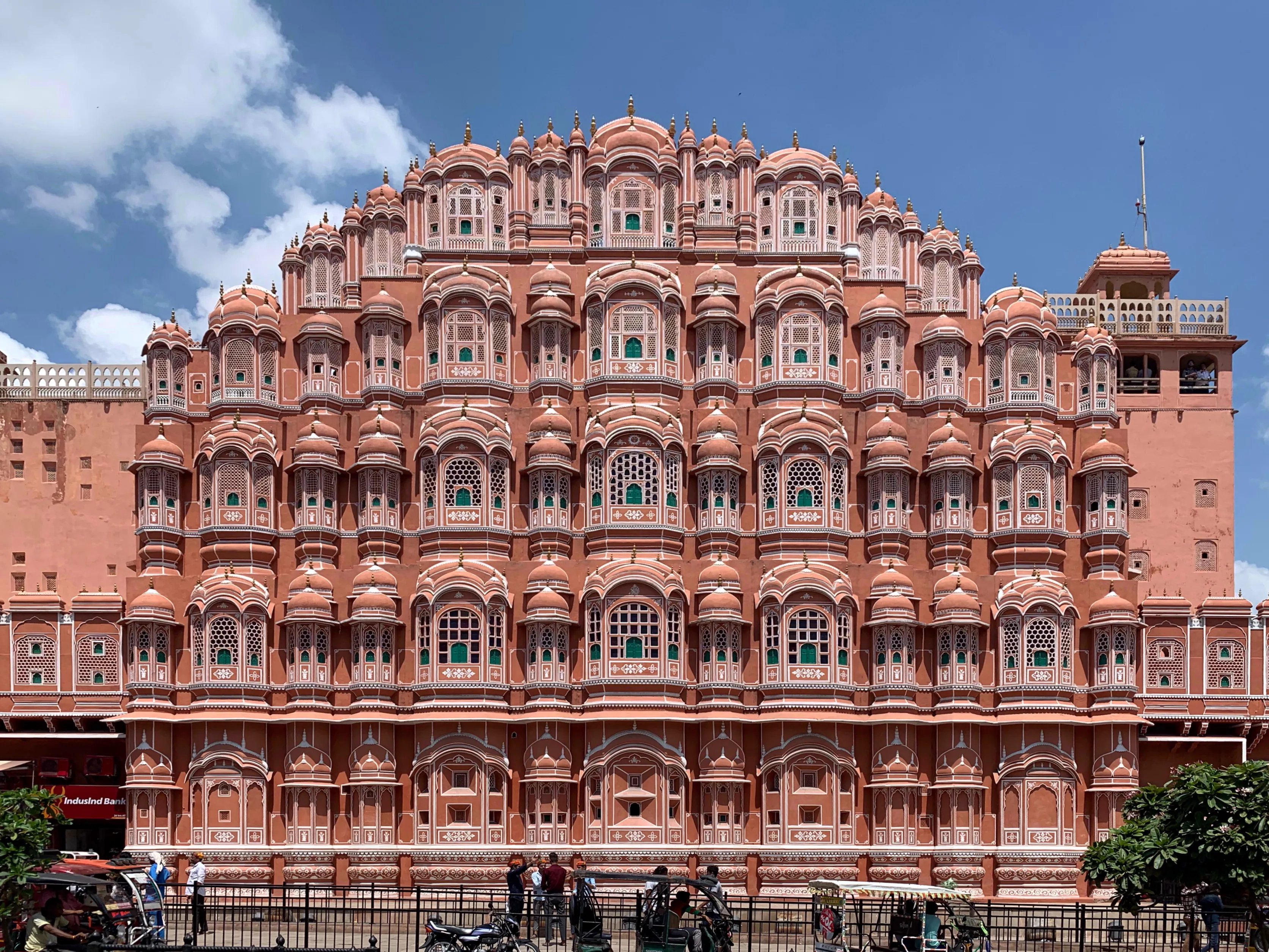
Featured
80% Documented
Hawa Mahal Rd, Badi Choupad, Jaipur (302002), Rajasthan, India, Rajasthan
The blush-pink facade of Hawa Mahal, rising like a solidified mirage from the heart of Jaipur's bustling streets, is an arresting sight. As someone deeply immersed in South Indian temple architecture, I was eager to experience this iconic structure and understand its unique place within the broader Indian architectural narrative. The sheer scale of the facade, a five-story honeycomb of 953 intricately carved jharokhas or windows, is initially overwhelming. Unlike the towering gopurams of Dravidian temples, Hawa Mahal's height is subtly distributed across its breadth, creating a rippling, almost textile-like effect. My initial impression was of a delicate screen, a veil between the bustling city and the secluded world within. This impression was reinforced as I entered the structure. The interior, surprisingly, is a series of relatively small, interconnected courtyards and chambers. The famed jharokhas, viewed from within, transform into intimate viewing galleries, framing snippets of the street life below. This perspective shift highlighted the palace's intended function: to allow the royal women to observe the city's activities without being seen. This contrasts sharply with the extroverted nature of South Indian temple architecture, where deities are placed in prominent positions for public darshan. The architectural style of Hawa Mahal, a blend of Rajput and Mughal influences, is evident in the intricate stone carvings. The delicate floral patterns and geometric motifs adorning the jharokhas reminded me of the intricate latticework found in Mughal architecture, while the overall form and the use of red and pink sandstone echoed the Rajput aesthetic. However, unlike the robust stonework of South Indian temples, which often feature elaborate sculptures of deities and mythical creatures, the carvings here are finer, almost lace-like, emphasizing ornamentation over narrative. Moving through the narrow passageways and ascending the gently sloping ramps (the palace has no stairs), I observed the clever use of ventilation. The numerous jharokhas, designed to catch the cool desert breeze, create a natural air conditioning system, a feature that gives the palace its name, "Palace of Winds." This ingenious passive cooling system is a testament to the architectural wisdom of the past, a stark contrast to the energy-intensive cooling systems of modern buildings. The view from the upper levels is breathtaking. The pink cityscape of Jaipur stretches out before you, punctuated by the imposing structures of the City Palace and Jantar Mantar. Looking back at the facade from within, I noticed how the sunlight filtering through the jharokhas created a mesmerizing play of light and shadow, transforming the interior spaces into a kaleidoscope of colors. This dynamic interplay of light and architecture is a feature I've often admired in South Indian temples, where sunlight is strategically used to illuminate the sanctum sanctorum. While the scale and grandeur of Hawa Mahal are undeniably impressive, it was the intricate details that truly captivated me. The delicate filigree work around the windows, the subtle variations in the pink sandstone, and the ingenious use of light and ventilation all speak to a sophisticated understanding of architectural principles. My visit to Hawa Mahal was not just a visual treat but also a valuable learning experience. It offered a fascinating glimpse into a different architectural tradition, highlighting the diversity and ingenuity of Indian architecture across regions and styles. It reinforced the idea that architecture is not merely about creating beautiful structures, but also about responding to the environment, fulfilling specific functions, and reflecting the cultural values of a particular time and place.
Palace
Rajput Period
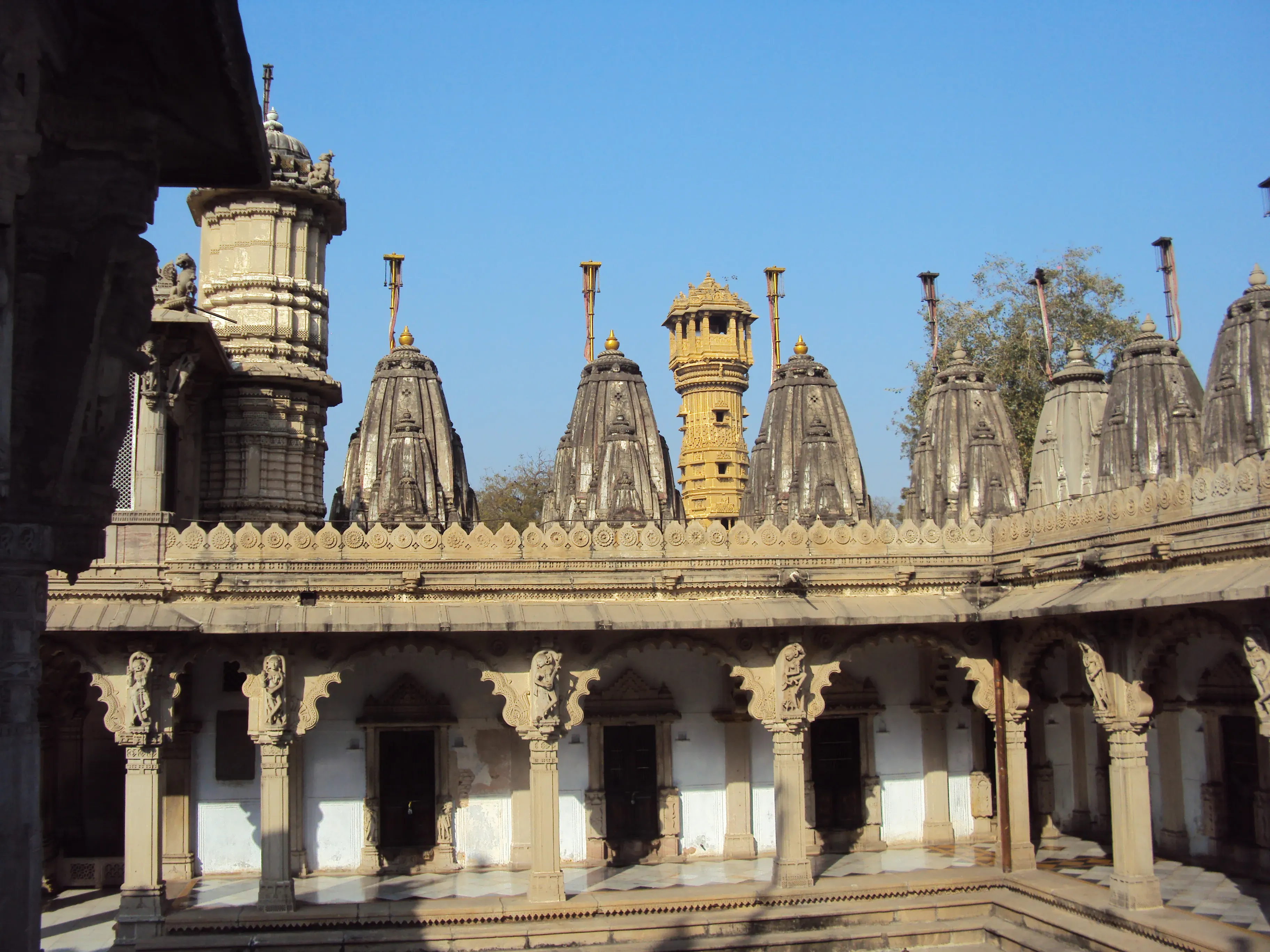
Featured
80% Documented
Shahibaug Rd, Shahibaug, Ahmedabad (380004), Gujarat, India, Gujarat
The midday sun cast long shadows across the courtyard, dappling the intricately carved marble of the Hutheesing Jain Temple. Stepping through the ornate torana, I felt a palpable shift, a sense of entering a sacred space meticulously crafted for contemplation and reverence. Located in the heart of bustling Ahmedabad, this 19th-century marvel stands as a testament to the enduring artistry of Jain craftsmanship and the devotion of its patrons. My lens, accustomed to the sandstone hues of Madhya Pradesh's ancient monuments, was immediately captivated by the sheer whiteness of the marble. It glowed, almost ethereal, against the azure sky. The main temple, dedicated to Dharmanatha, the fifteenth Jain Tirthankara, is a symphony in stone. Fifty-two intricately carved shrines, each housing a Tirthankara image, surround the central sanctum. The sheer density of the carvings is breathtaking. Floral motifs, celestial beings, and intricate geometric patterns intertwine, creating a visual tapestry that demands close inspection. I spent hours moving from shrine to shrine, my camera attempting to capture the nuances of each individual sculpture, the delicate expressions on the faces of the deities, the flow of the drapery, the minute details that spoke volumes about the skill of the artisans. The temple’s architecture follows the Māru-Gurjara style, a distinctive blend of architectural elements that I found particularly fascinating. The domed ceilings, the ornate pillars, the intricate brackets supporting the balconies – each element contributed to a sense of grandeur and harmony. The play of light and shadow within the temple added another layer of visual interest. As the sun shifted, the carvings seemed to come alive, revealing new details and textures. I found myself constantly repositioning, seeking the perfect angle to capture the interplay of light and form. Beyond the main temple, the courtyard itself is a marvel. The paved floor, polished smooth by centuries of footsteps, reflects the surrounding structures, creating a sense of spaciousness. Smaller shrines and pavilions dot the courtyard, each a miniature masterpiece of carving and design. I was particularly drawn to the Manastambha, a freestanding pillar adorned with intricate carvings, standing tall in the center of the courtyard. It served as a powerful visual reminder of the Jain principles of non-violence and universal compassion. One aspect that struck me was the palpable sense of peace that permeated the temple complex. Despite its location in a busy city, the Hutheesing Jain Temple felt like an oasis of tranquility. The hushed whispers of devotees, the gentle clinking of bells, the rhythmic chanting of prayers – all contributed to an atmosphere of serenity and reverence. It was a stark contrast to the cacophony of the streets outside. As a heritage photographer, I’ve visited countless temples across India, but the Hutheesing Jain Temple holds a special place in my memory. It’s not just the architectural brilliance or the sheer artistry of the carvings, but the palpable sense of devotion and the peaceful atmosphere that truly sets it apart. It’s a place where spirituality and art intertwine, creating an experience that is both visually stunning and deeply moving. My photographs, I hope, will serve as a testament to the enduring beauty and spiritual significance of this remarkable temple, allowing others to glimpse the magic I witnessed within its marble walls.
Temple
British Colonial Period

Featured
80% Documented
Jahangir Mahal Road, Niwari, Orchha (472246), Madhya Pradesh, India, Madhya Pradesh
The imposing sandstone edifice of Jahangir Mahal rose before me, a testament to Mughal grandeur amidst the quiet town of Orchha, Madhya Pradesh. Having explored every UNESCO site in India, I can confidently say that this palace holds a unique charm, a blend of Rajput and Mughal architectural styles that speaks volumes about the confluence of cultures that shaped this region. The sheer scale of the structure is initially overwhelming. Its massive walls, punctuated by intricately carved chhatris and jharokhas, seem to stretch endlessly towards the cerulean sky. Stepping through the colossal gateway, I was transported back in time. The courtyard, vast and open, whispered stories of royal processions and grand durbars. The silence, broken only by the chirping of birds and the distant hum of the Betwa River, allowed me to truly absorb the atmosphere. I could almost envision the Mughal emperor Jahangir, for whom the palace was built, holding court here, surrounded by his entourage. The architecture of Jahangir Mahal is a fascinating study in contrasts. The robust, almost fortress-like exterior, a characteristic of Rajput architecture, gives way to surprisingly delicate and ornate interiors. The walls are adorned with intricate geometric patterns, floral motifs, and depictions of animals, showcasing the Mughal influence. I was particularly captivated by the exquisite tilework, predominantly in shades of turquoise and blue, that added a vibrant splash of colour to the sandstone backdrop. I ascended the steep, narrow staircases, each step worn smooth by centuries of footfalls. The climb was rewarded with breathtaking panoramic views of Orchha and the surrounding countryside. From this vantage point, the strategic importance of the Mahal became clear. The elevated position offered a commanding view of the Betwa River and the surrounding plains, allowing for early detection of approaching armies. Exploring the various chambers and halls, I noticed the clever use of light and ventilation. Despite the thick walls and the scorching Madhya Pradesh sun, the interiors remained relatively cool. The strategically placed jharokhas, besides their aesthetic appeal, allowed for cross-ventilation, while the intricate jaalis cast beautiful patterns of light and shadow on the floors and walls. One of the most striking features of the Mahal is the series of interconnected courtyards, each with its own distinct character. Some were intimate and secluded, perhaps meant for private gatherings, while others were grand and open, designed for public audiences. I spent a considerable amount of time simply wandering through these courtyards, imagining the lives of the people who once inhabited this magnificent palace. The chhatris, those elegant domed pavilions that crown the roof, are perhaps the most iconic element of Jahangir Mahal. These structures, with their intricate carvings and delicate arches, add a touch of ethereal beauty to the otherwise robust structure. Standing beneath one of these chhatris, gazing out at the sprawling landscape, I felt a profound sense of connection to the past. My visit to Jahangir Mahal was more than just a sightseeing trip; it was a journey through time. It was a chance to witness the grandeur of the Mughal empire and the architectural ingenuity of a bygone era. While I have been fortunate enough to experience the magnificence of all of India's UNESCO World Heritage Sites, Jahangir Mahal, with its unique blend of architectural styles and its palpable sense of history, holds a special place in my memory. It's a must-see for anyone seeking to understand the rich tapestry of Indian history and culture.
Palace
Rajput Period
Related Collections
Discover more heritage sites with these related collections
Explore More Heritage
Explore our research archive. Each site includes historical context, architectural analysis, construction techniques, and preservation status. Perfect for academic research and heritage studies.